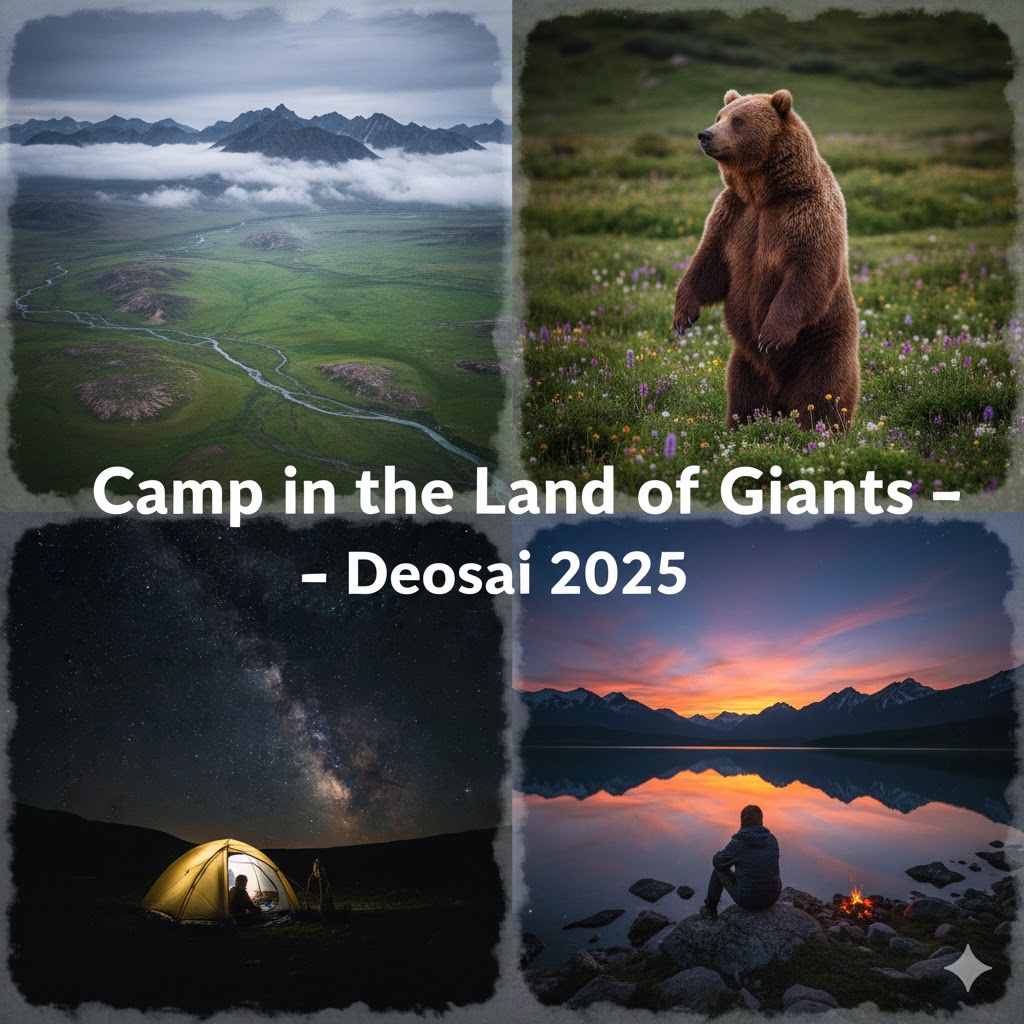Introduction: Where the Earth Meets the Sky
Deosai National Park camping guide 2025 reveals the ultimate adventure across Pakistan’s highest plains. From breathtaking Sheosar Lake to hidden meadows at Bara Pani, this guide covers every detail: trekking routes, wildlife spotting, camping tips, and luxury glamping with Glamp Pakistan.
At over 13,000 feet above sea level, Deosai National Park — known as “The Land of Giants” — unfolds as one of the most surreal landscapes in Pakistan. Stretching between Skardu and Astore, Deosai is not just a national park; it’s a world above clouds where snow-fed streams cut through endless meadows of wildflowers and marmots peek curiously from their burrows. For campers and nature lovers, this is Pakistan’s ultimate wilderness — raw, untamed, and soul-stirring.
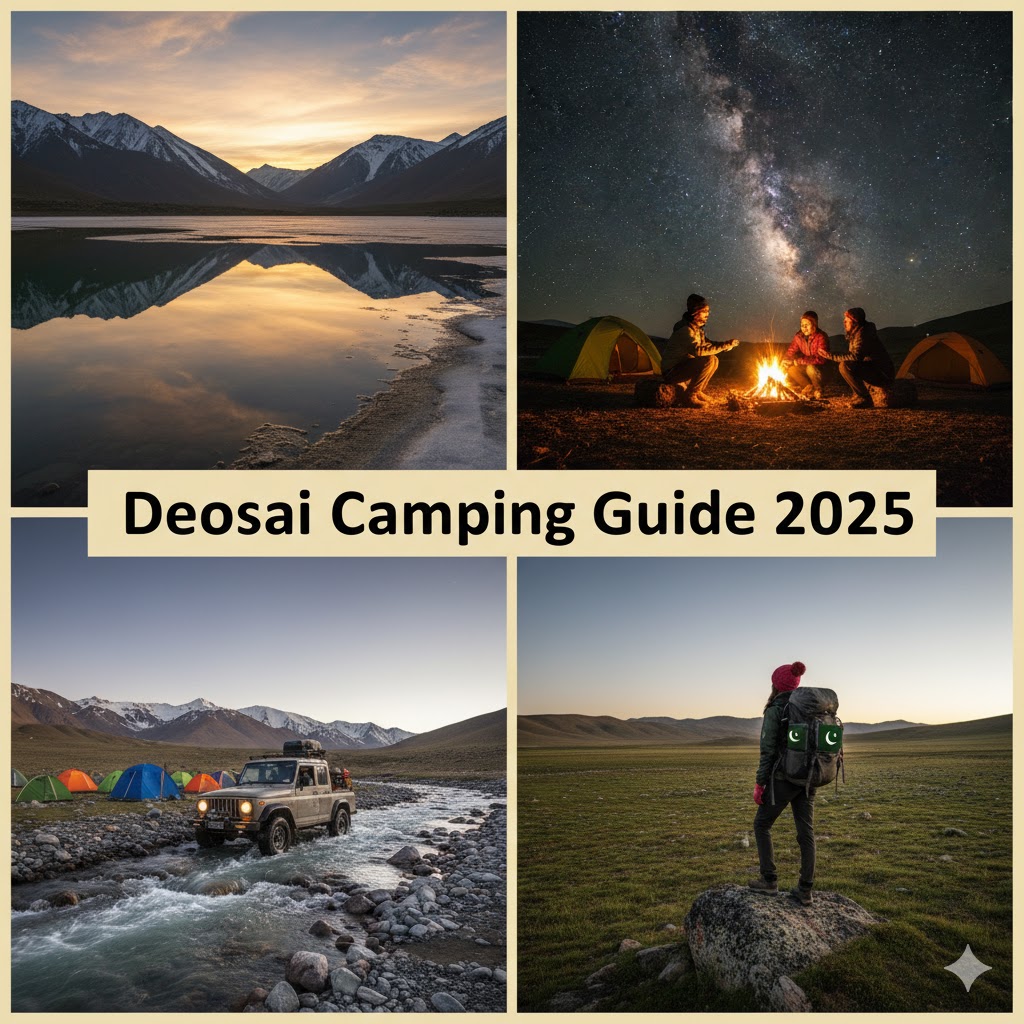
🌿 Why Camp in Deosai?
Camping in Deosai is about disconnecting from the digital noise and reconnecting with nature’s rhythm. Every sunrise here feels like an awakening — the pinkish glow over Sheosar Lake, the calls of migratory birds, and the crisp alpine air set the perfect backdrop for wilderness camping. Unlike typical campgrounds, Deosai offers wild camping — you set up tents near lakes or meadows and live freely under the stars.
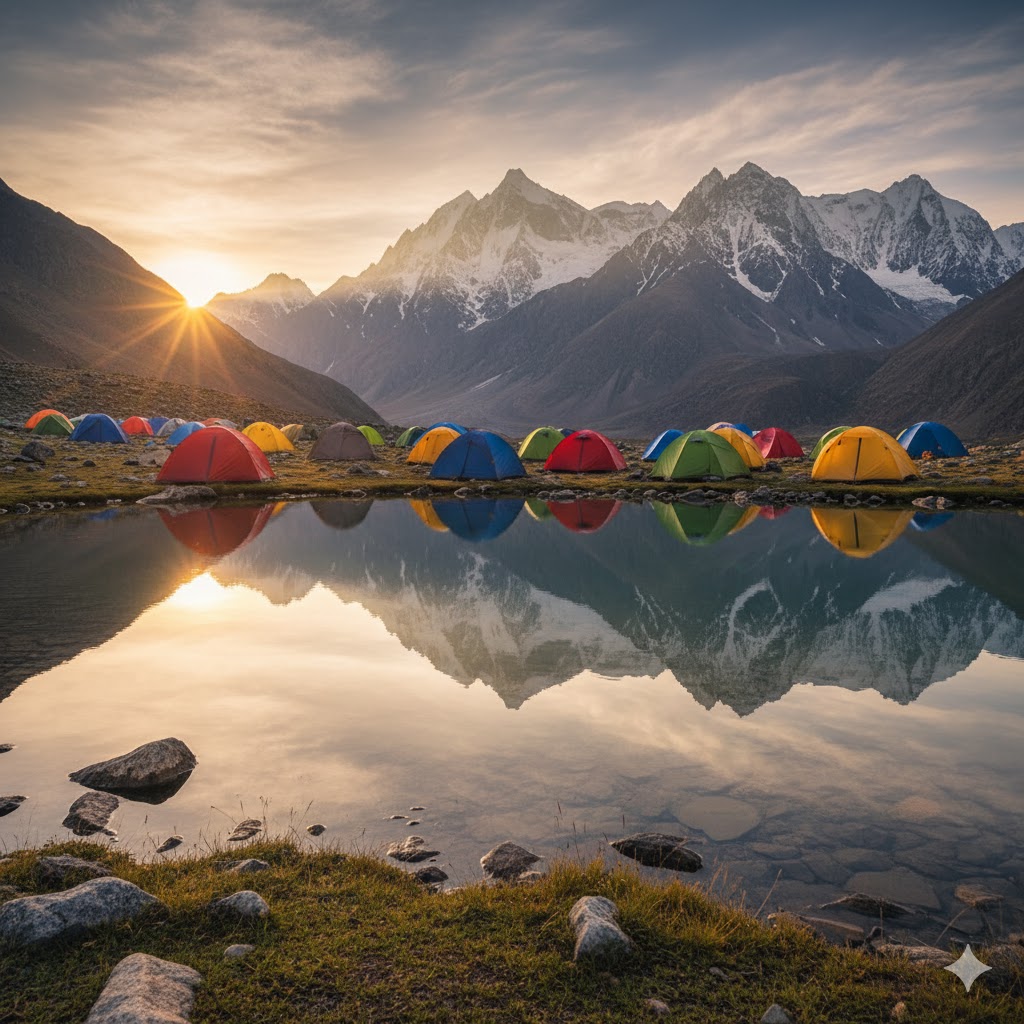
🏕️ Best Camping Spots in Deosai National Park
- Sheosar Lake (Mirror Lake)
The crown jewel of Deosai. The reflection of snow-capped Nanga Parbat on Sheosar’s calm waters is breathtaking. Camp on its northwestern banks for stunning sunset views.
Tip: Nights are freezing even in July — bring layered thermal wear. - Bara Pani (Big River)
The heart of Deosai and most popular camping zone. Flowing streams, yak herders nearby, and relatively flat ground make it perfect for tents.
Tip: Local jeep drivers can help set up camps or rent you basic gear. - Kala Pani (Black Water Stream)
Less crowded and more isolated. Ideal for experienced campers seeking quiet serenity.
Tip: Bring mosquito repellent — the meadows near water can get buggy at night. - Deosai Top (Viewpoint Ridge)
Offers panoramic views of the entire plateau. Best for photographers and stargazers.
Tip: Strong winds — secure your tent well and pack windbreakers.
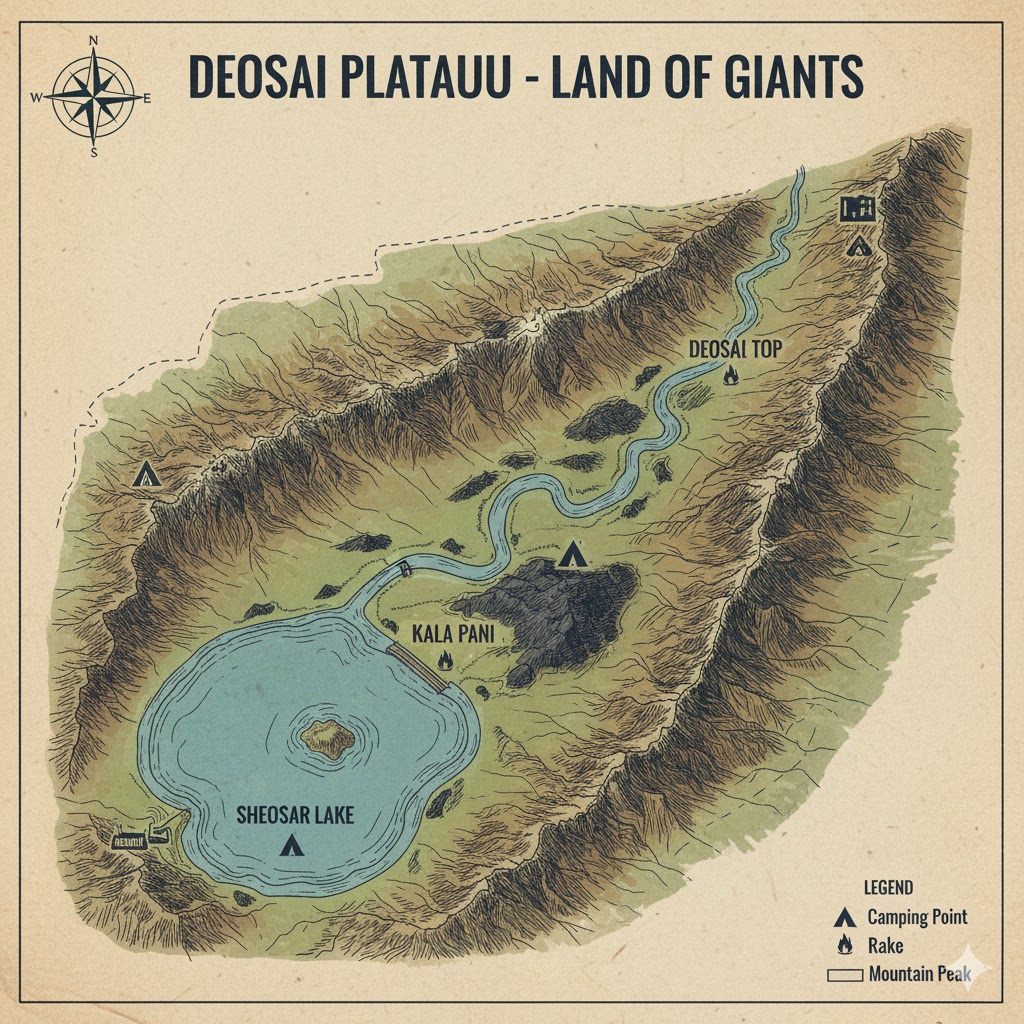
🚗 How to Reach Deosai National Park
There are two main routes to access Deosai:
- From Skardu (Most Common):
Take a 4×4 from Skardu city via Sadpara Lake to reach the park’s entry point at Bara Pani.
Travel Time: 2.5–3 hours by jeep. - From Astore (Alternate Route):
A scenic yet rugged path through Chilum Chowki and Deosai Top.
Travel Time: 4–5 hours (recommended for experienced drivers).
Travel Tip: Always check the weather forecast before departure. Snowfall can close access roads even in late spring.
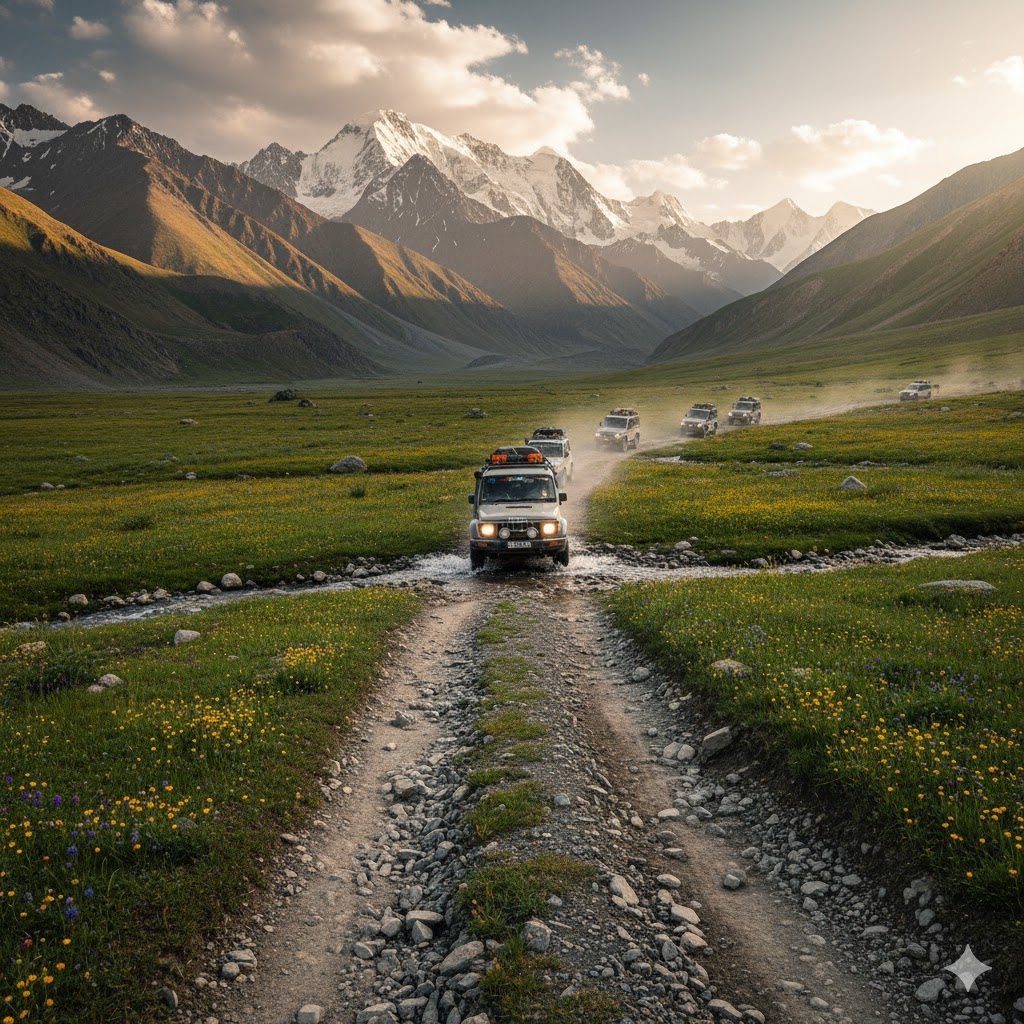
🌄 Best Time to Visit Deosai National Park
- Open Season: June to September
- Ideal Camping Months: Mid-July to late August
During these months, meadows bloom with wildflowers, marmots and Himalayan brown bears are visible, and roads remain open.
Avoid: Early June (melting snow can block trails) and September end (temperatures drop below freezing).
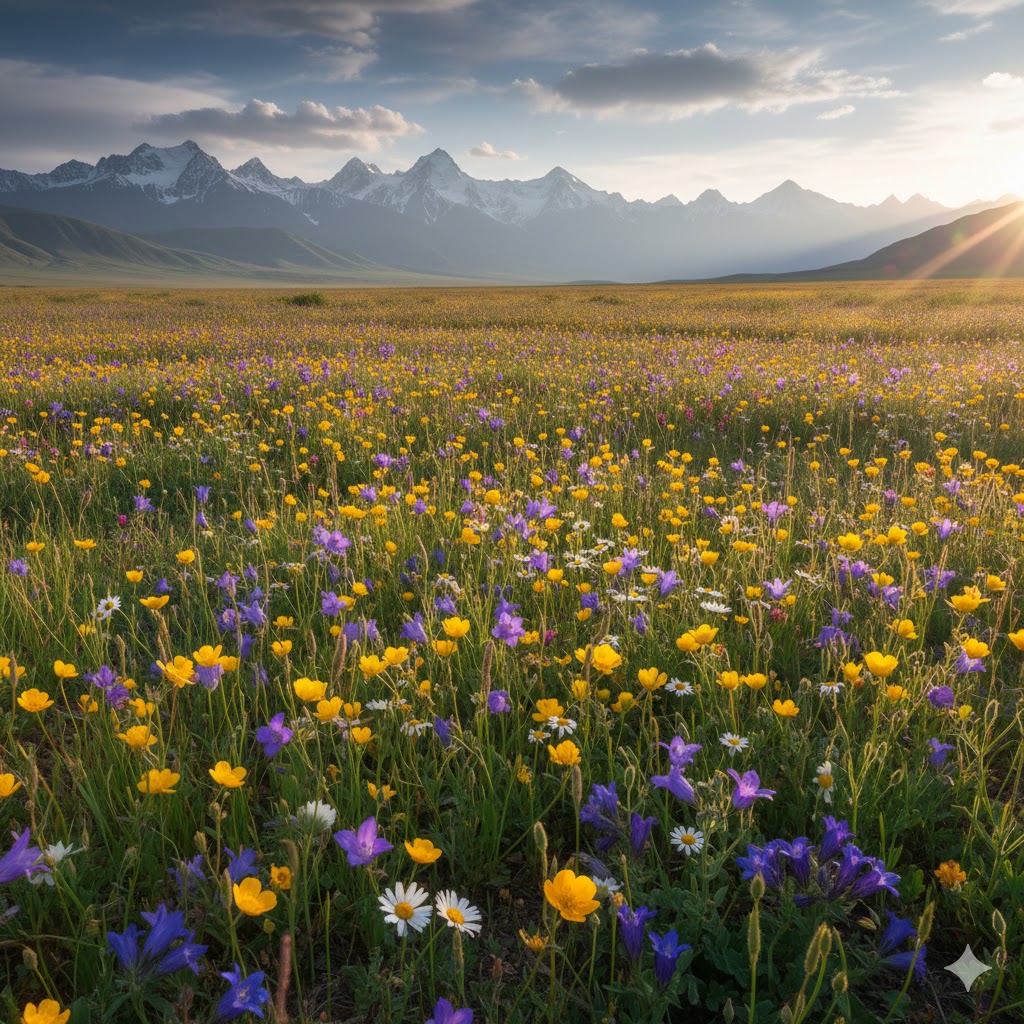
🐻 Wildlife & Flora You’ll Encounter
Deosai National Park is home to some of the rarest wildlife species in the world.
- Himalayan Brown Bear (symbol of Deosai)
- Snow Leopard (extremely rare sighting)
- Golden Marmots (friendly meadow dwellers)
- Red Foxes, Ibex, Migratory Birds, and countless wildflower species
Tip: Always maintain a 100-meter distance from wild animals and avoid cooking food close to your sleeping tent.
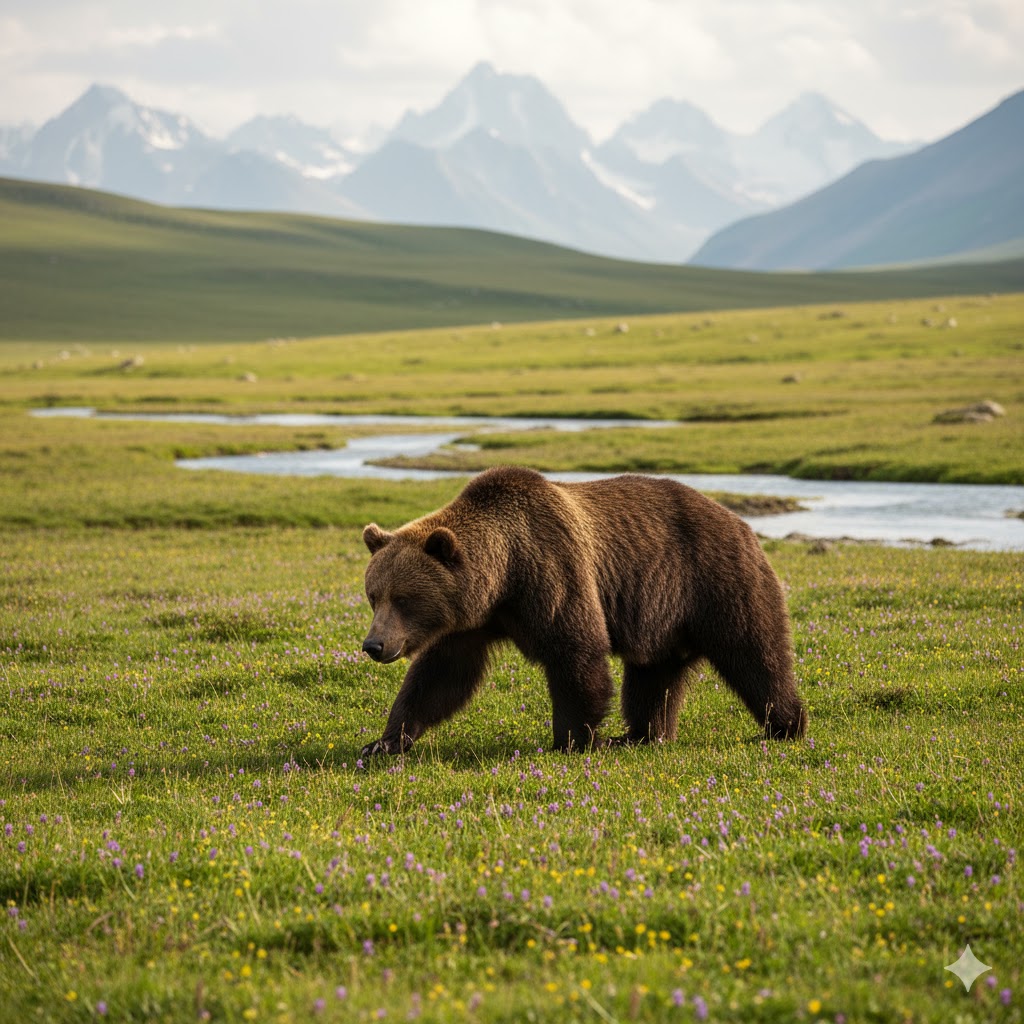
🏔️ Camping Essentials & Packing Checklist
Here’s what every Deosai camper must pack:
- Weatherproof tent + groundsheet
- Sleeping bag (rated for -5°C or below)
- Portable stove or campfire gear
- Water filter + hydration packs
- Solar power bank / flashlight
- High-calorie snacks and energy bars
- Medical kit + altitude sickness tablets
- Binoculars and camera
Pro Tip: Local shops in Skardu offer tent rentals and camping packages for 2–3 days.
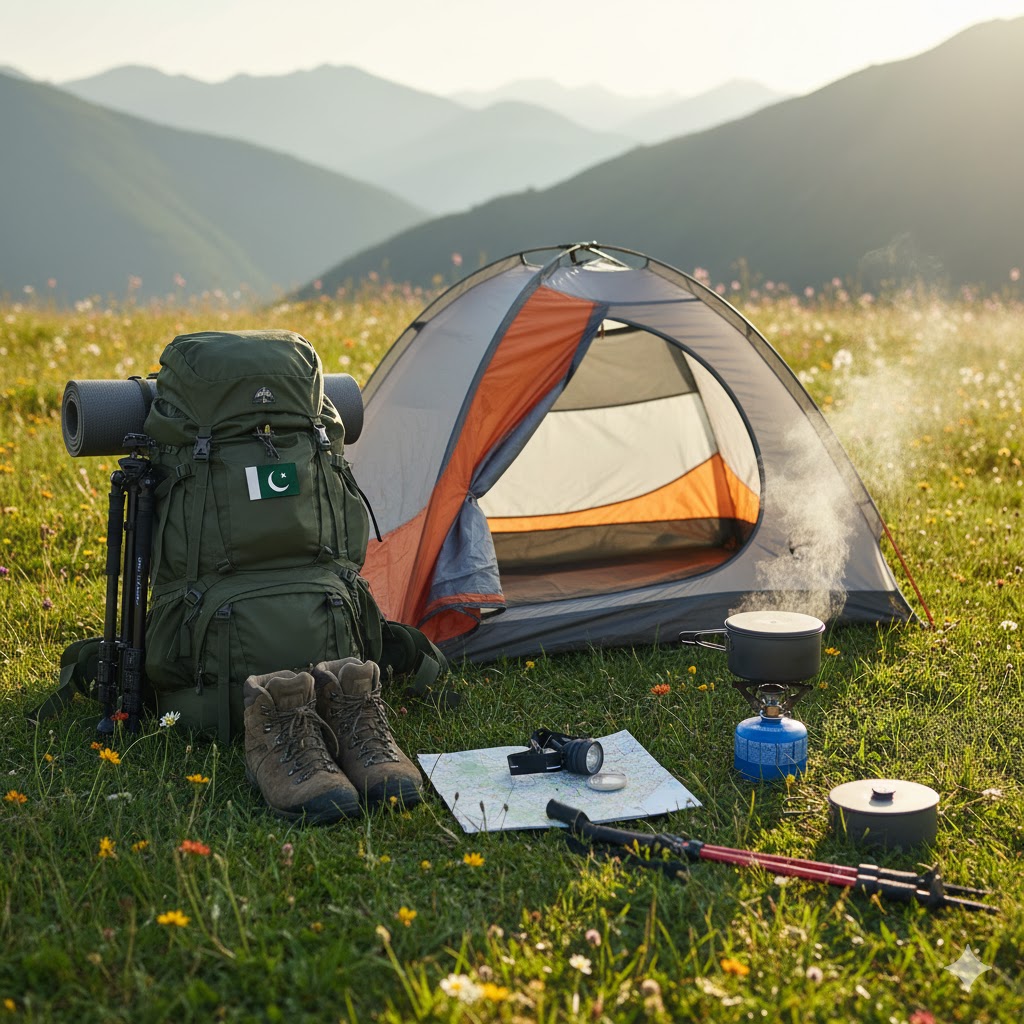
💡 Local Tips & Hidden Insights
- Hire a local guide for safety and navigation support.
- Always carry National Park entry permits (available at Sadpara checkpoint).
- No cellular service beyond Sadpara — use walkie-talkies or satellite devices.
- Leave no trace — carry all waste back with you.
- Bonfires are allowed only in designated spots to prevent wildfires.
🏞️ Deosai at Night: The Starry Wonder
When the sun sets, Deosai transforms into one of the clearest stargazing spots in the world. With no city lights and pure mountain air, the Milky Way shines so bright it feels within reach. Campers often describe it as “sleeping under a galaxy.”
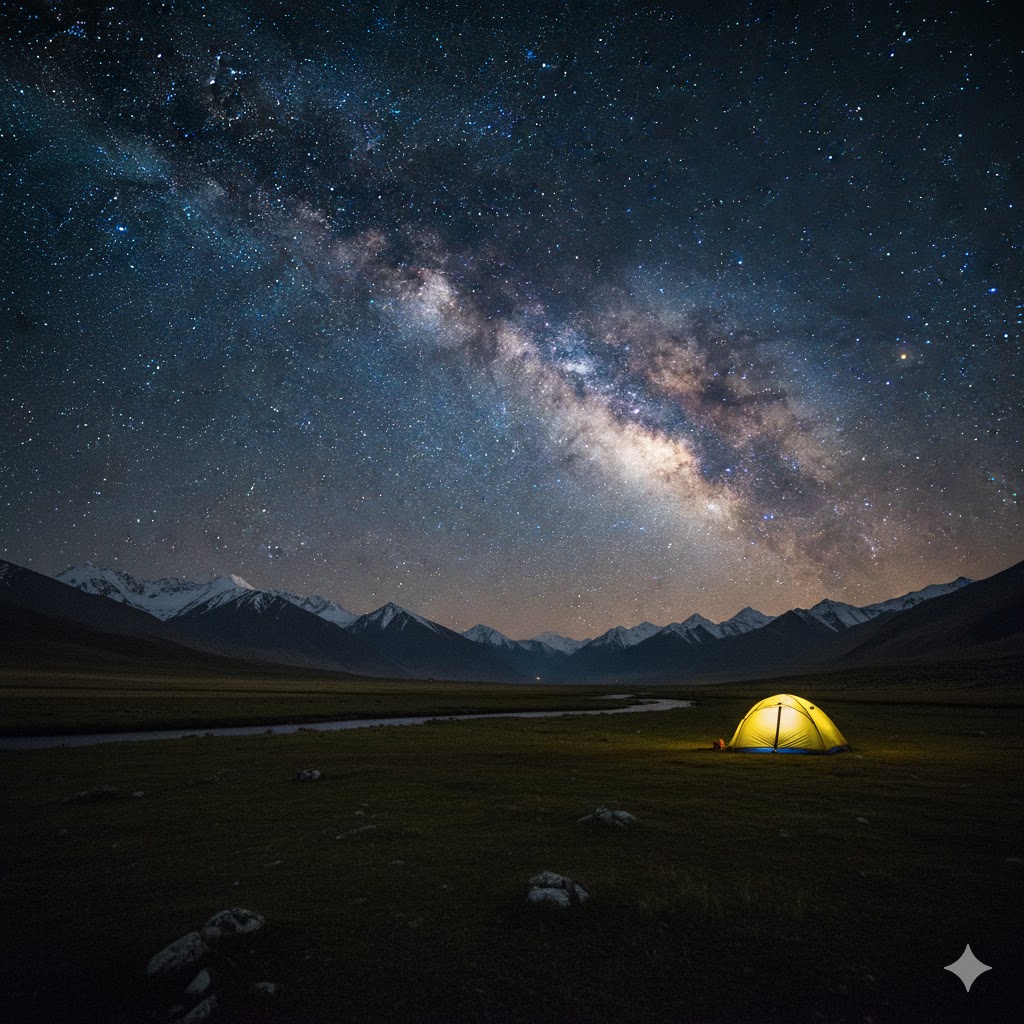
🍲 Food & Supplies
You won’t find restaurants inside Deosai — it’s pure wilderness.
- Nearest food supply points: Skardu & Chilum Chowki.
- Carry packed food, dry rations, and drinking water.
- Locals sometimes sell yak milk, tea, and parathas near Bara Pani.
💰 Entry Fee & Permits (2025)
| Category | Entry Fee (PKR) |
|---|---|
| Local Tourists | 200 |
| Foreign Tourists | 1000 |
| Vehicle Entry (4×4) | 300 |
| Camping Fee | 500/night |
Permits are checked at Sadpara Gate or Chilum Check Post, depending on your route.
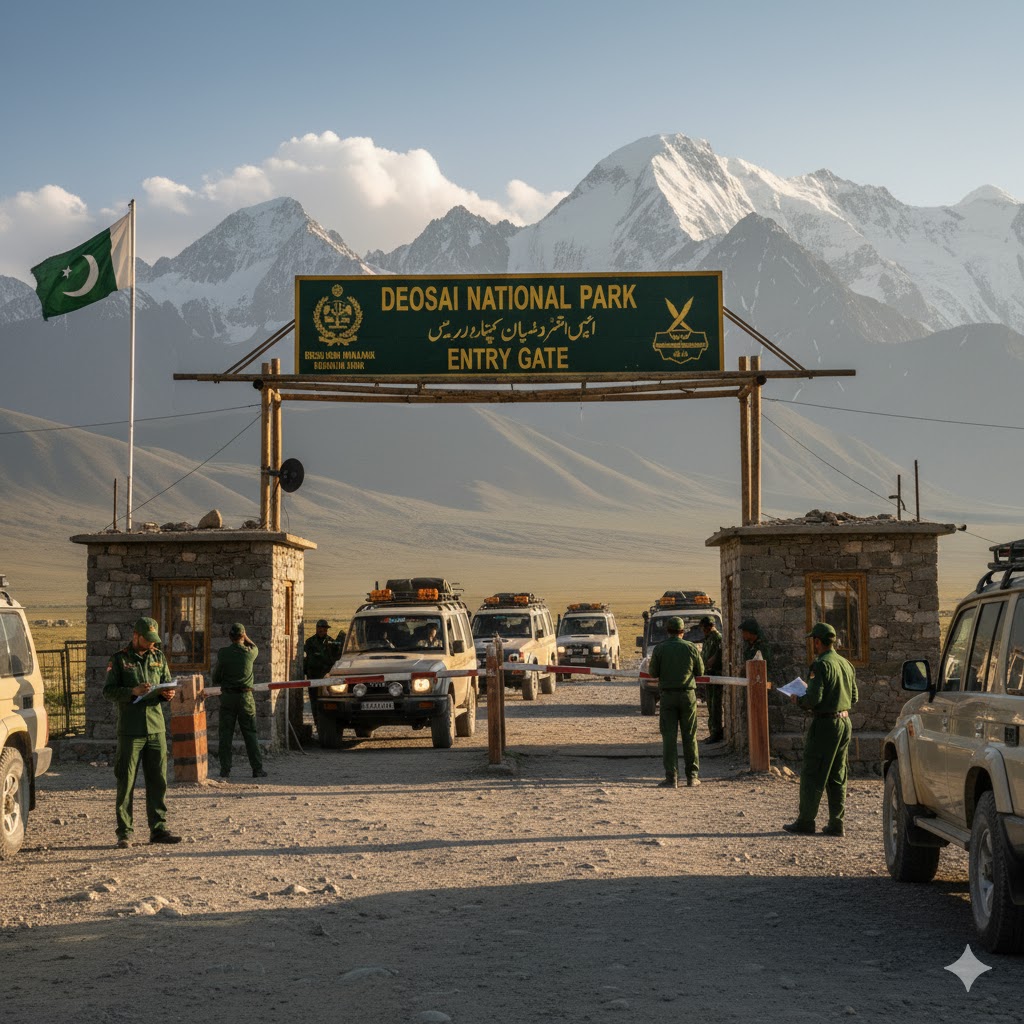
🌍 Responsible Travel & Eco Guidelines
Deosai’s fragile ecosystem demands eco-responsible tourism:
- Never disturb wildlife or pick flowers.
- Avoid loud music; embrace nature’s silence.
- Use biodegradable waste bags.
- Support local communities by hiring local drivers and guides.
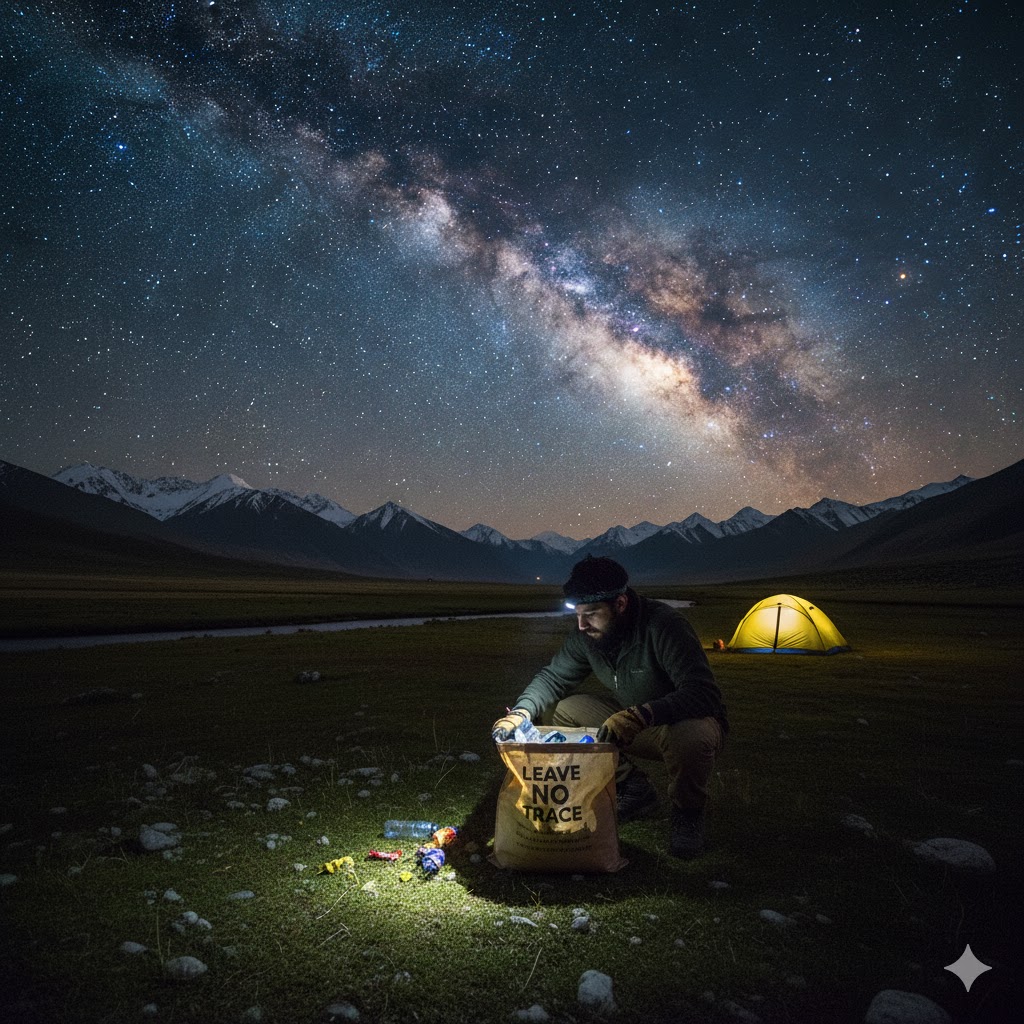
🏕️ Internal & External Travel Resources
Internal Links:
External Links (DoFollow):
🧭 Conclusion: Where Silence Speaks Louder Than Words
Camping at Deosai National Park is more than just a trip — it’s a journey into silence, stars, and solitude. Whether you’re a hiker, photographer, or dreamer, this high-altitude wilderness reminds you how small yet connected we are to nature. If you ever wish to escape the world for a while, Deosai awaits — untouched, undisturbed, and unforgettable.
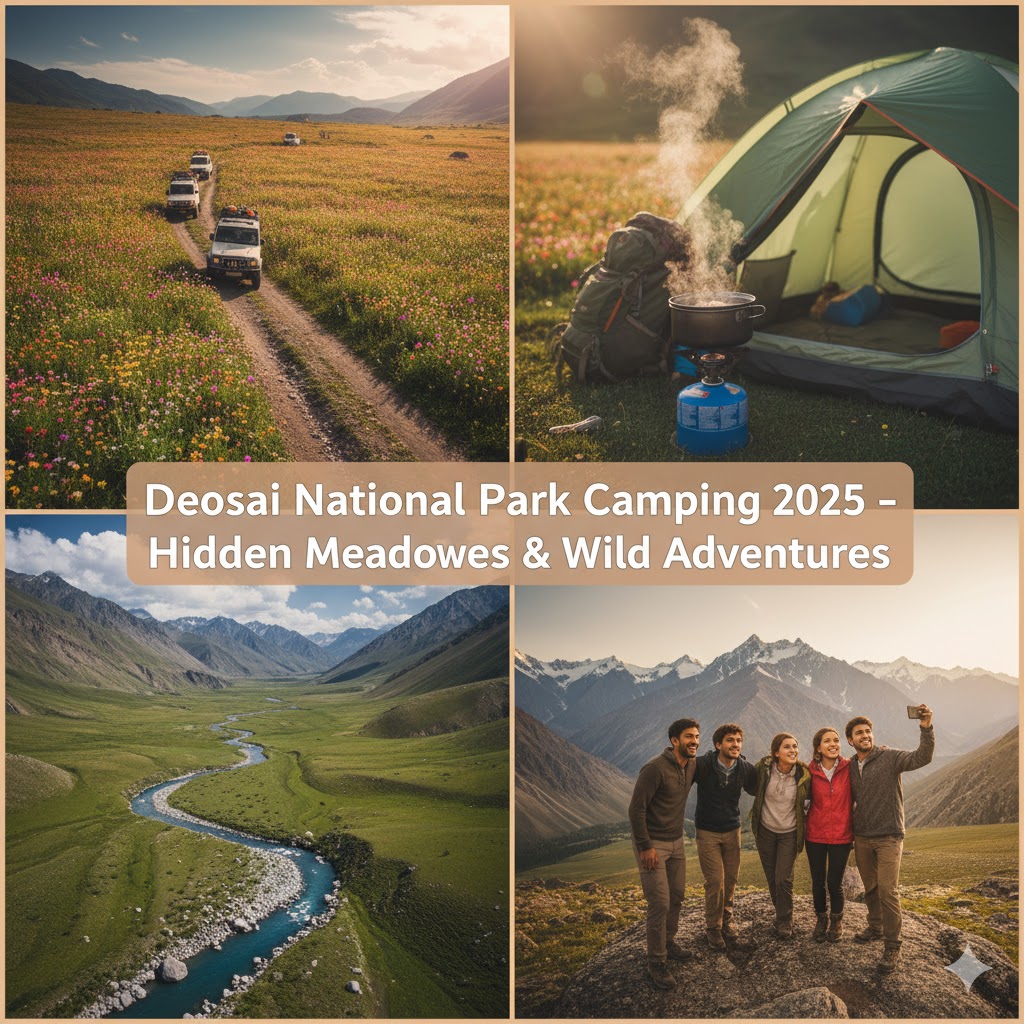
❓FAQs — Deosai National Park Camping Guide 2025
1. Is camping allowed anywhere in Deosai?
Yes, but it’s recommended to camp near Sheosar Lake, Bara Pani, or Kala Pani where ground conditions are stable.
2. Is it safe to camp with wildlife around?
Yes — if you maintain distance, avoid open food, and follow park regulations.
3. How cold does it get at night?
Even in summer, temperatures drop to -5°C at night — bring proper gear.
4. Do I need a permit to camp?
Yes. Obtain it at park entry points (Sadpara or Chilum Check Post).
5. Are there washrooms or rest areas?
Only basic public toilets near Bara Pani; otherwise, wild camping facilities.
6. Can I rent camping equipment locally?
Yes, Skardu has multiple tour operators offering tent and gear rentals.
7. Is it accessible by regular car?
No — only 4×4 jeeps can handle the rough terrain.
8. What should I avoid doing?
Avoid littering, loud noises, off-trail driving, or wildlife feeding.
Hidden Trails and Untouched Corners of Deosai National Park
While most travelers stop at Sheosar Lake or Bara Pani, true adventurers know Deosai’s real charm lies beyond the main road. The vast plateau hides secret trails, alpine streams, and offbeat ridges that only locals and shepherds know.
🧭 1. Churmang Valley Link Trail
Located southwest of Bara Pani, the Churmang link trail offers one of the quietest trekking paths in Deosai. It follows crystal-clear streams that eventually join the Indus River near Skardu. The route is dotted with wild rose shrubs and purple lupines.
Best for: Photographers and solo trekkers.
Duration: 2–3 hours (one way).
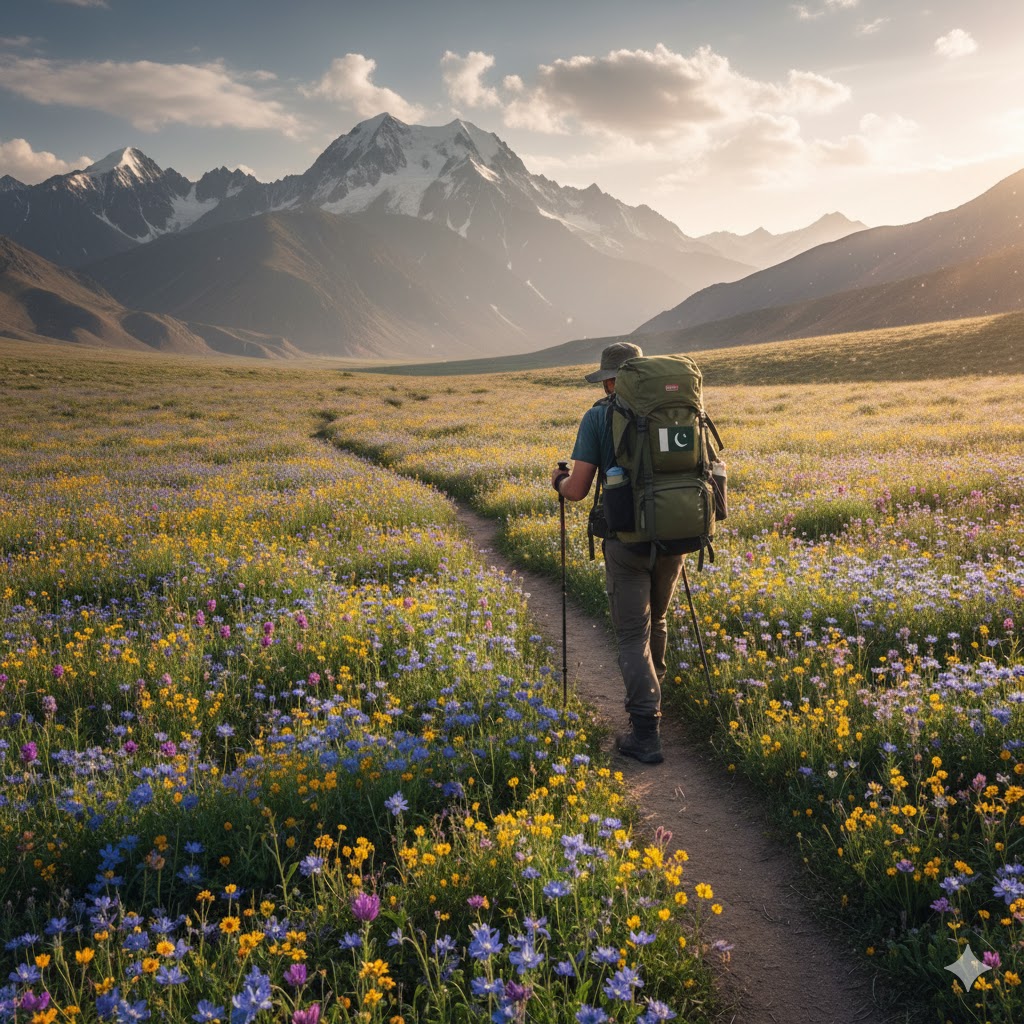
🧭 2. Shatung Ridge Hike
A lesser-known 4 km ascent from the plains near Kala Pani. The ridge provides 360° panoramic views of Sheosar Lake, the snow peaks of Nanga Parbat, and the distant Karakoram ranges. At sunrise, this spot glows like a painted masterpiece.
Best for: Sunrise photography, adventure hikers.
Tip: Start hike before 5 AM — winds pick up quickly after 9 AM.
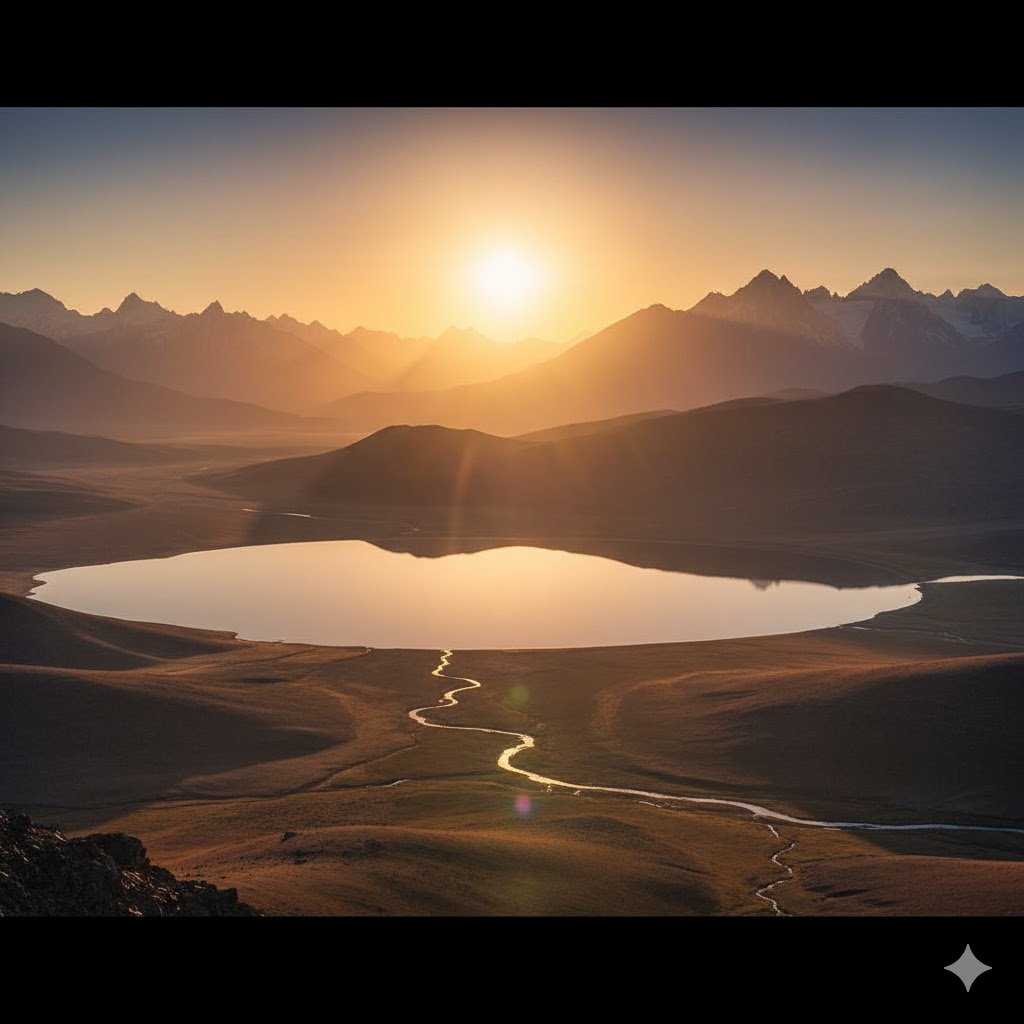
🧭 3. Bara Pani to Sheosar Lake Trek
For those who prefer walking over jeeps, this trekking trail is ideal. It runs roughly 20 km across open plains filled with marmot colonies. You’ll witness glaciers melting into silver streams — a living example of untouched wilderness.
Recommended Duration: 2 days (with one night camp mid-route).
Level: Moderate.
Tip: Carry at least 3 liters of water; there are no shops or refill points along the way.
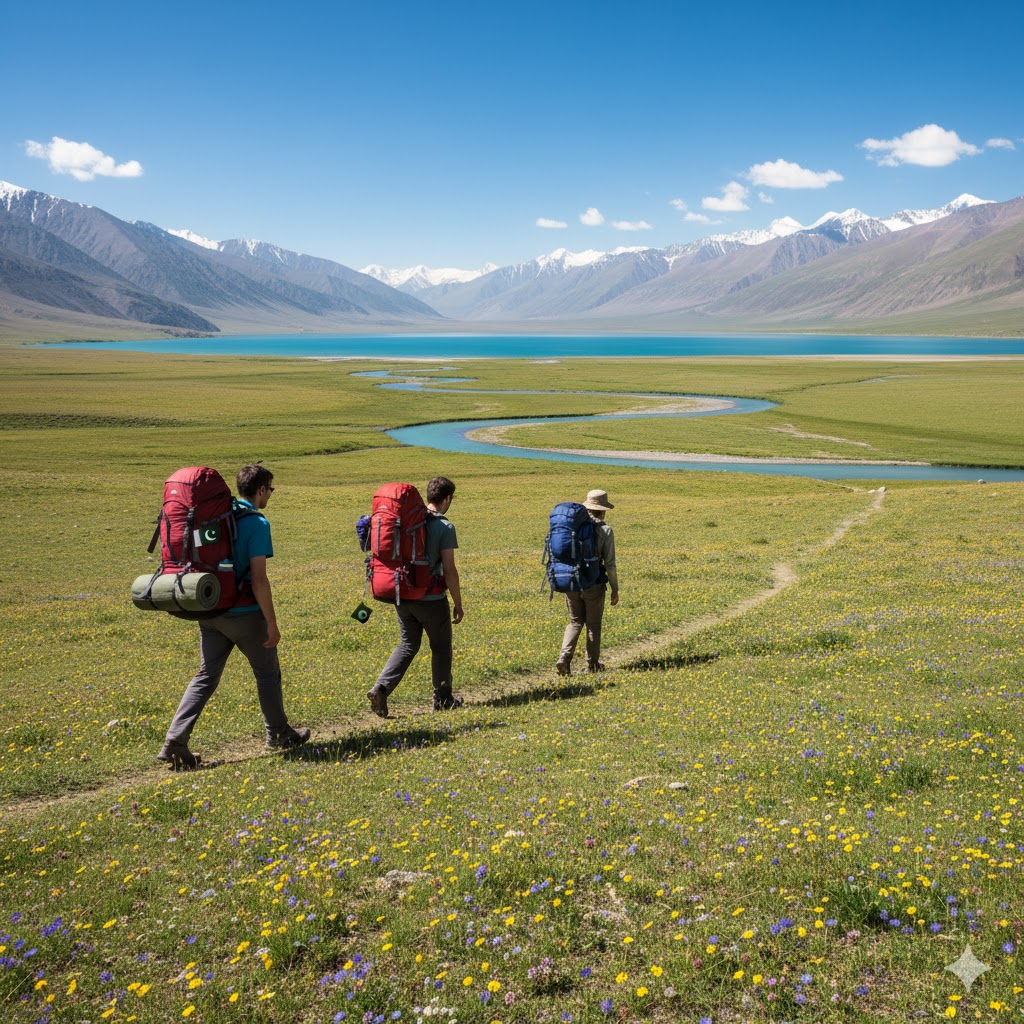
📸 Best Photography Spots in Deosai National Park
Deosai is a photographer’s paradise. From macro shots of alpine flowers to dramatic landscape panoramas, every frame tells a story of untouched beauty.
- Sheosar Lake Golden Hour – Capture reflection of Nanga Parbat in early morning light.
- Bara Pani Bridge – Iconic shot of jeeps crossing the wooden bridge over roaring streams.
- Wildflower Fields near Kala Pani – Perfect for macro photography in August.
- Milky Way Nights – Long exposure astrophotography from Deosai Top.
- Marmot Portraits – These playful creatures make great wildlife close-ups.
Photography Tip: Use a tripod and ND filters; Deosai’s bright sunlight can cause overexposure.
🧡 The People of Deosai – Nomads & Guardians of the Plains
Deosai isn’t entirely uninhabited. During summer, Balti shepherds and nomads migrate here with their flocks. Their camps are a cultural window into simple mountain living. Visitors can sometimes share a cup of salted butter tea and learn stories passed through generations.
These locals act as guardians of Deosai, protecting livestock from predators and ensuring balance with nature. Many serve as volunteer spotters for WWF’s Himalayan bear project.
Cultural Tip: Always greet locals with a smile and a friendly “Assalam-o-Alaikum.” Offering small snacks like biscuits or tea is appreciated.
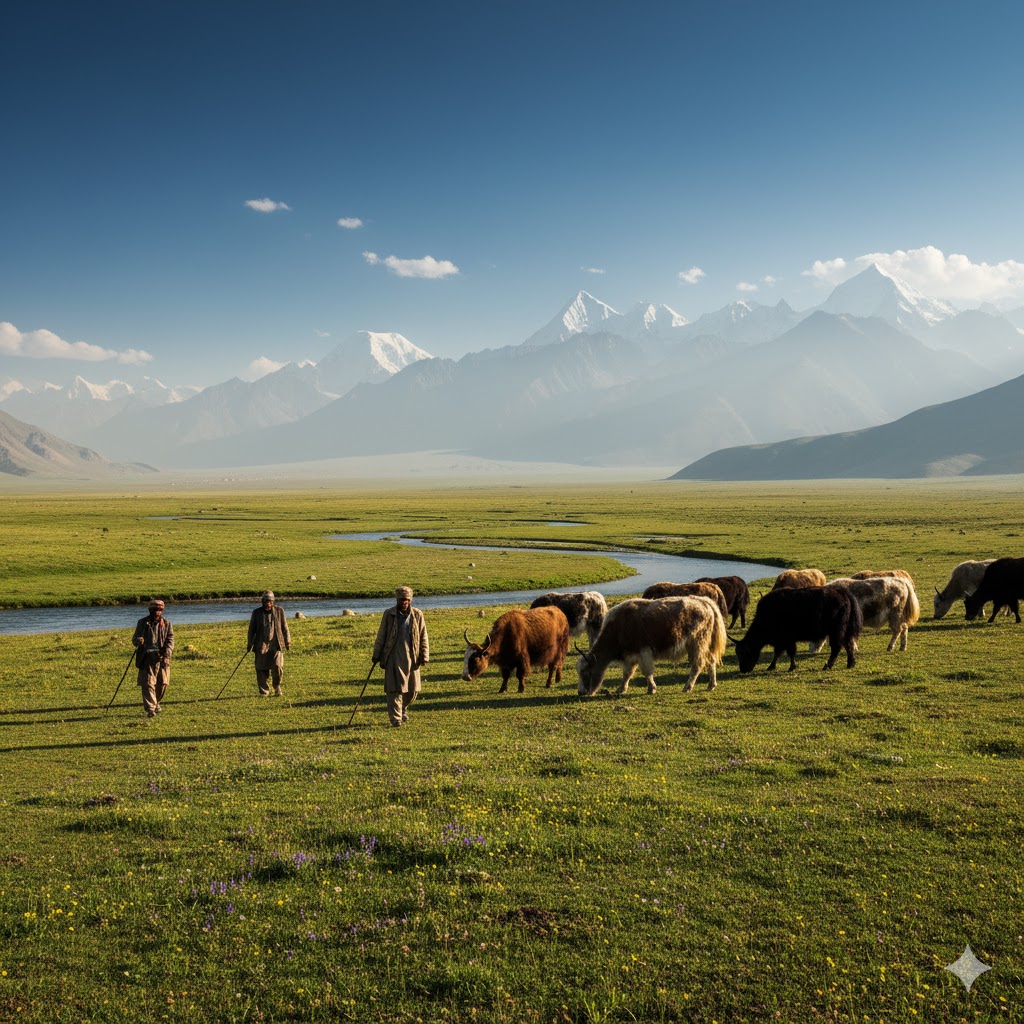
🐾 The Himalayan Brown Bear Conservation Story
Deosai is one of the last remaining strongholds for the Himalayan brown bear, a species once on the brink of extinction. In the early 1990s, only 19 bears were recorded. Thanks to conservation efforts by WWF Pakistan and local communities, the number now exceeds 70.
Visitors often see them from a distance around Kala Pani or Deosai Top — usually grazing or resting. To support conservation:
- Never approach or feed bears.
- Report any sightings to rangers.
- Avoid leaving food scraps.
These actions help maintain the delicate ecosystem that defines Deosai’s wild character.
🛻 Adventure Routes & 4×4 Expeditions
Deosai’s rugged terrain attracts off-road enthusiasts from across Pakistan. Jeep tours are organized from Skardu and Astore, offering full-day expeditions across high-altitude meadows.
🧩 Popular 4×4 Routes:
- Skardu – Sadpara – Bara Pani – Sheosar Lake – Astore
(Full crossing, approx. 5–6 hours drive) - Skardu – Bara Pani Loop (Return)
(Day trip for light campers or photographers) - Astore – Chilum – Deosai Top – Bara Pani – Skardu Exit
(Perfect for overlanders or bikers)
Vehicle Tip: Use diesel-powered 4x4s with high clearance; petrol vehicles may overheat at altitude. Always carry extra fuel — there are no stations inside the park.
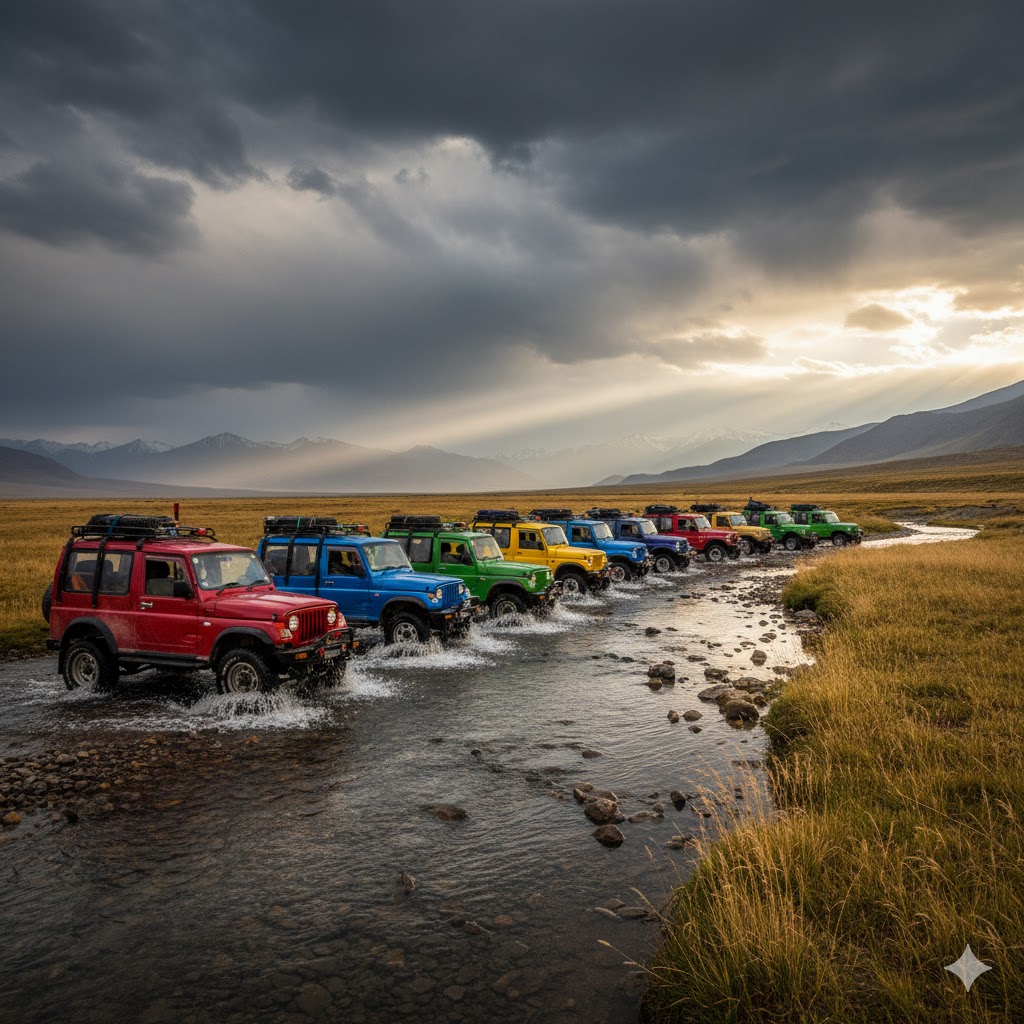
🧳 Extended Travel Itinerary — 3-Day Deosai Camping Plan (2025)
Here’s a sample 3-day itinerary ideal for travelers planning a complete Deosai experience.
Day 1 – Skardu to Bara Pani
- Depart from Skardu after breakfast.
- Stop at Sadpara Lake for photos.
- Arrive at Bara Pani by noon, set up camp.
- Explore nearby meadows and enjoy dinner by the bonfire.
Overnight: Camping at Bara Pani.
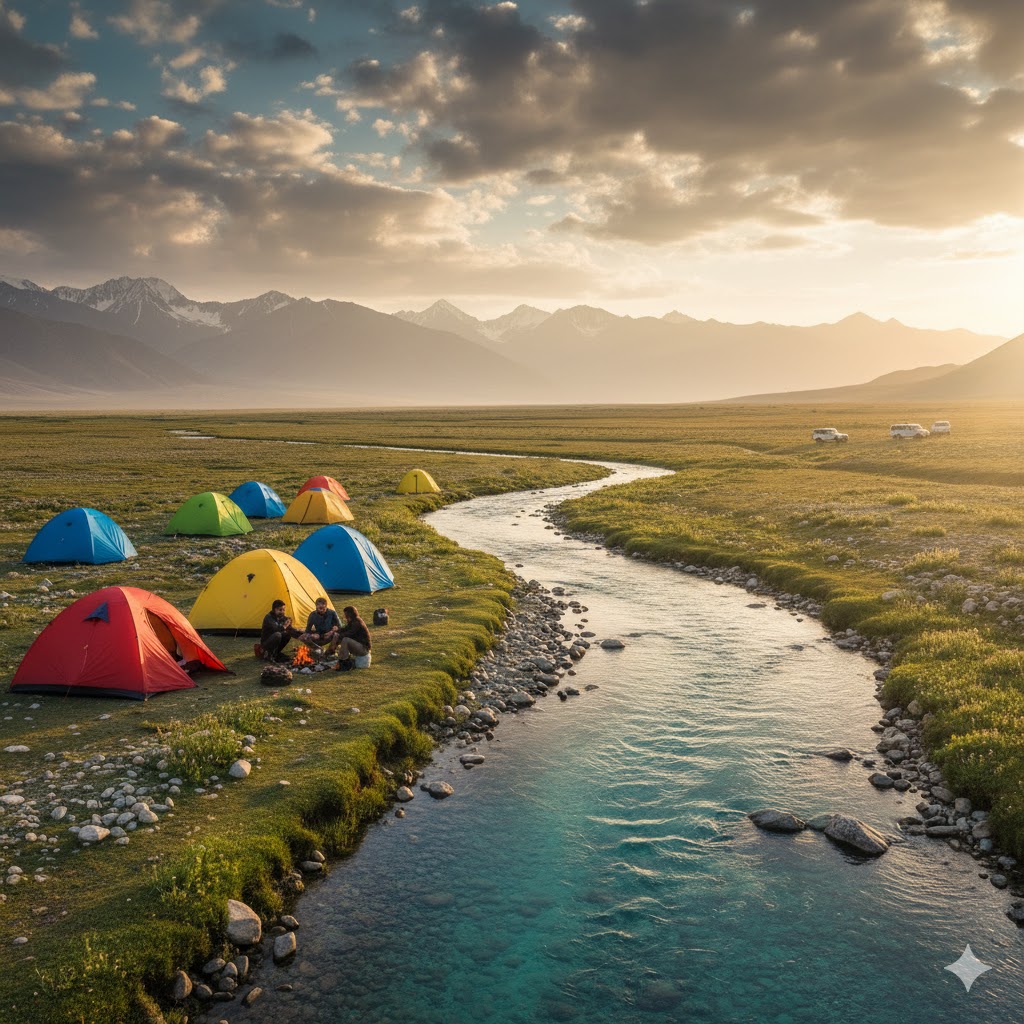
Day 2 – Trek to Sheosar Lake
- Early morning departure on foot or jeep.
- Capture golden hour photos along the trail.
- Picnic lunch at Sheosar Lake viewpoint.
- Return to Bara Pani or camp overnight near Sheosar.
Overnight: Camping near Sheosar Lake (with wind protection setup).
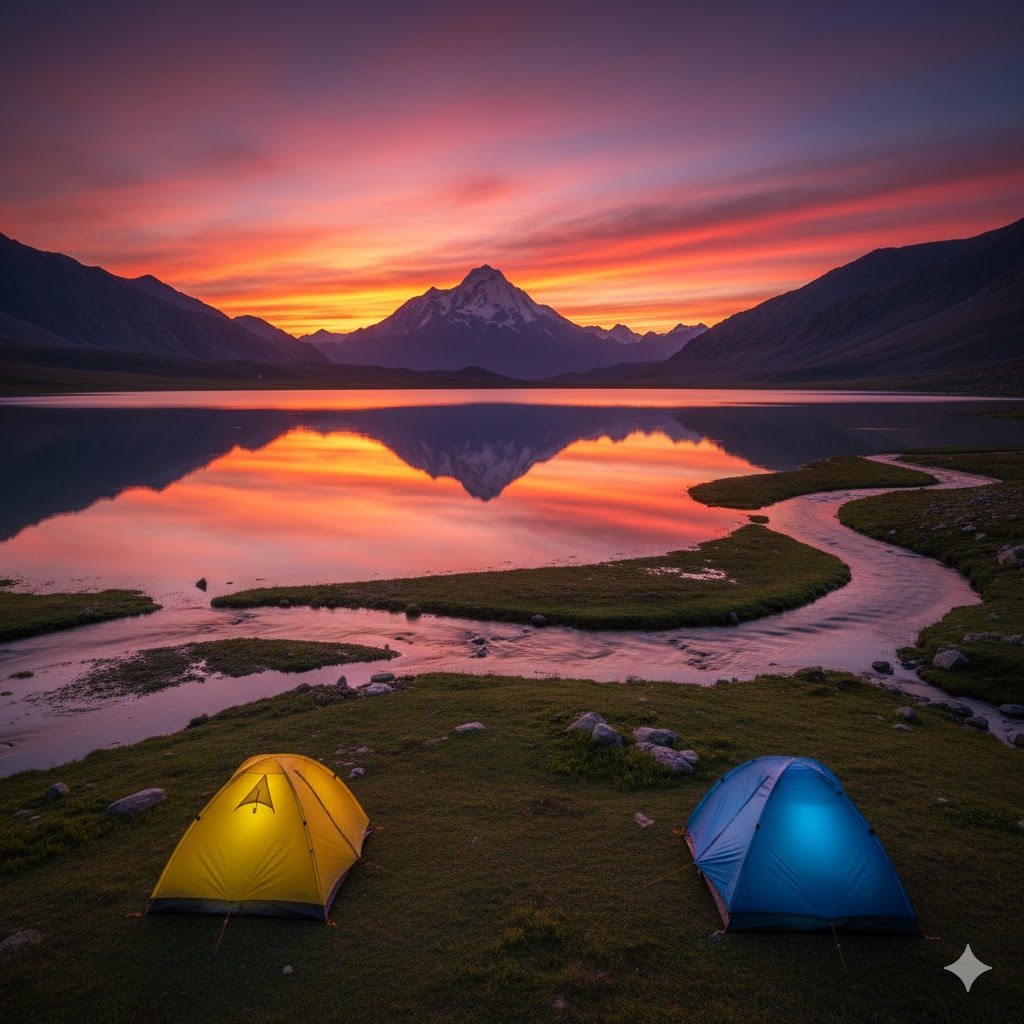
Day 3 – Wildlife Exploration & Return
- Early wildlife spotting near Kala Pani.
- Breakfast with local nomads (yak milk tea).
- Return to Skardu or continue onward to Astore.
- Optional detour to Chilum Chowki viewpoint.
Trip End: Evening arrival back to Skardu.
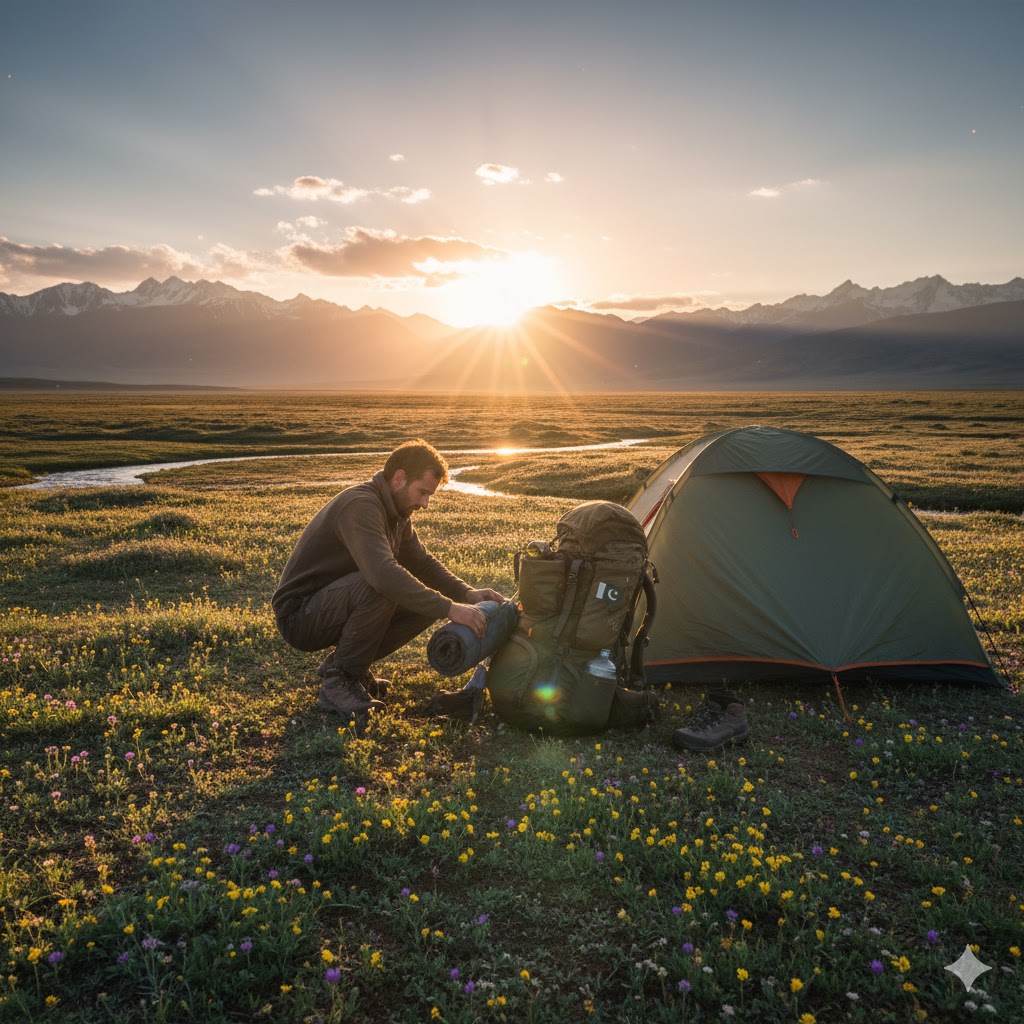
🌦️ Weather Patterns & Altitude Considerations
Deosai’s climate is unpredictable. Despite sunny mornings, clouds can roll in within minutes.
| Month | Temperature Range (°C) | Conditions |
|---|---|---|
| June | -2 to 15 | Cold mornings, snow patches |
| July | 0 to 18 | Ideal camping, wildflowers bloom |
| August | 1 to 16 | Bear sightings, heavy rains at times |
| September | -5 to 10 | Clear skies, cold nights |
Altitude Tips:
- Move slowly to avoid altitude sickness.
- Stay hydrated and avoid alcohol.
- If you feel dizzy, descend immediately to Skardu or Chilum Chowki.
📶 Connectivity, Safety & Emergency Info
There’s no mobile network inside Deosai National Park. For emergencies:
- Carry satellite phone or walkie-talkies.
- Closest hospital: CMH Skardu (approx. 3 hours from Bara Pani).
- Park Rangers patrol the area between Sadpara Gate and Bara Pani daily.
- Always inform your accommodation or guide about your return plan.
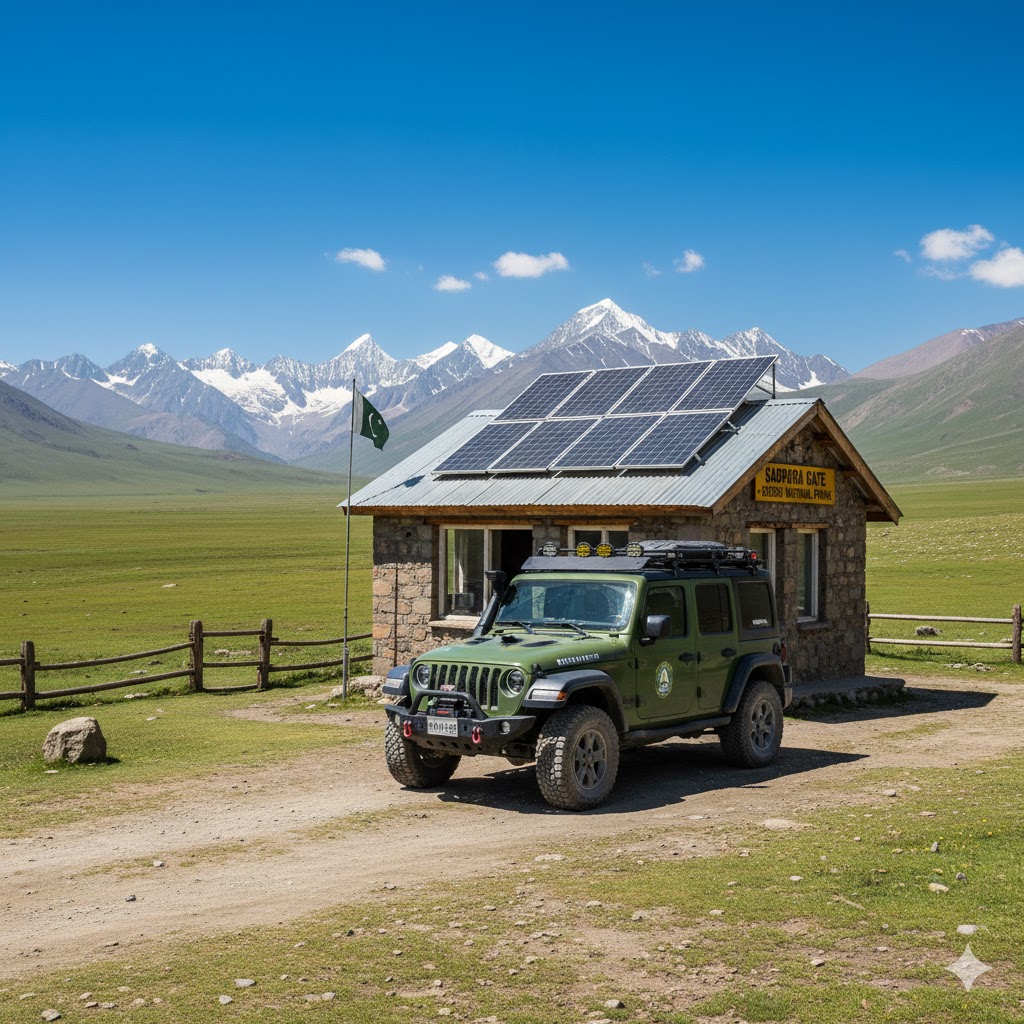
🎒 Budget Breakdown (Approx. 3-Day Trip – 2025)
| Item | Estimated Cost (PKR) |
|---|---|
| 4×4 Jeep Rental | 12,000–15,000 |
| Camping Gear (rental) | 3,000–5,000 |
| Entry + Camping Fees | 1,000 |
| Food Supplies | 3,000 |
| Guide (optional) | 2,000 |
| Miscellaneous | 2,000 |
Total (Per Person): 8,000–12,000 PKR (for group of 4–5 travelers).
See More:
Sources:
Traveler Guide: The Wilderness That Heals
Deosai is not just a place — it’s an emotion that stays long after you leave. When night falls, and you’re surrounded by silence so deep it hums, you understand why locals call it “the roof of the world.”
Every gust of wind tells a story of survival. Every sunrise feels like creation’s first morning. So when you camp here, don’t just chase photos — chase the feeling of being alive in the world’s last great wilderness.
❓Additional FAQs — Extended (2025 Edition)
9. Can families visit Deosai for day trips?
Yes. Families can enjoy picnics at Bara Pani or Sheosar Lake with guided jeep tours from Skardu.
10. Are there restroom facilities for campers?
Only basic ones near Bara Pani checkpoint — carry portable toilet kits for remote areas.
11. What kind of drone footage is allowed?
Personal drones can be used with park ranger permission; no wildlife disturbance permitted.
12. Are campfires allowed anywhere?
Only in designated zones and with dry wood. Avoid burning grass or litter.
13. What’s the altitude sickness remedy if symptoms appear?
Rest, hydrate, descend to lower elevation. Avoid sleeping immediately after meals.
14. Is Deosai accessible by motorbikes?
Yes, adventure bikers frequently cross Deosai — just ensure your bike is tuned for off-road terrain.
15. What are the local foods or snacks to try before camping?
Try Balti Gosht, Apricot Soup, and Yak Butter Tea in Skardu — rich in calories and perfect for the cold.
Festivals, Culture & Seasonal Gatherings Around Deosai
Though Deosai itself is uninhabited for most of the year, the nearby valleys — Skardu, Astore, and Chillum — burst to life during summer with vibrant mountain festivals celebrating nature, livestock, and local heritage.
🎉 1. Skardu Polo Festival
Held every July at the Skardu Polo Ground, this is one of the region’s grandest sporting events. Traditional music, colorful dresses, and fierce polo matches attract visitors from across Pakistan.
After the festival, many travelers continue onward to Deosai National Park for camping adventures.
Highlight: Watch the sunset from the Skardu Fort after the matches — the view across the Indus Valley is unforgettable.
Local Tip: Reserve accommodation early; hotels fill up quickly during festival week.
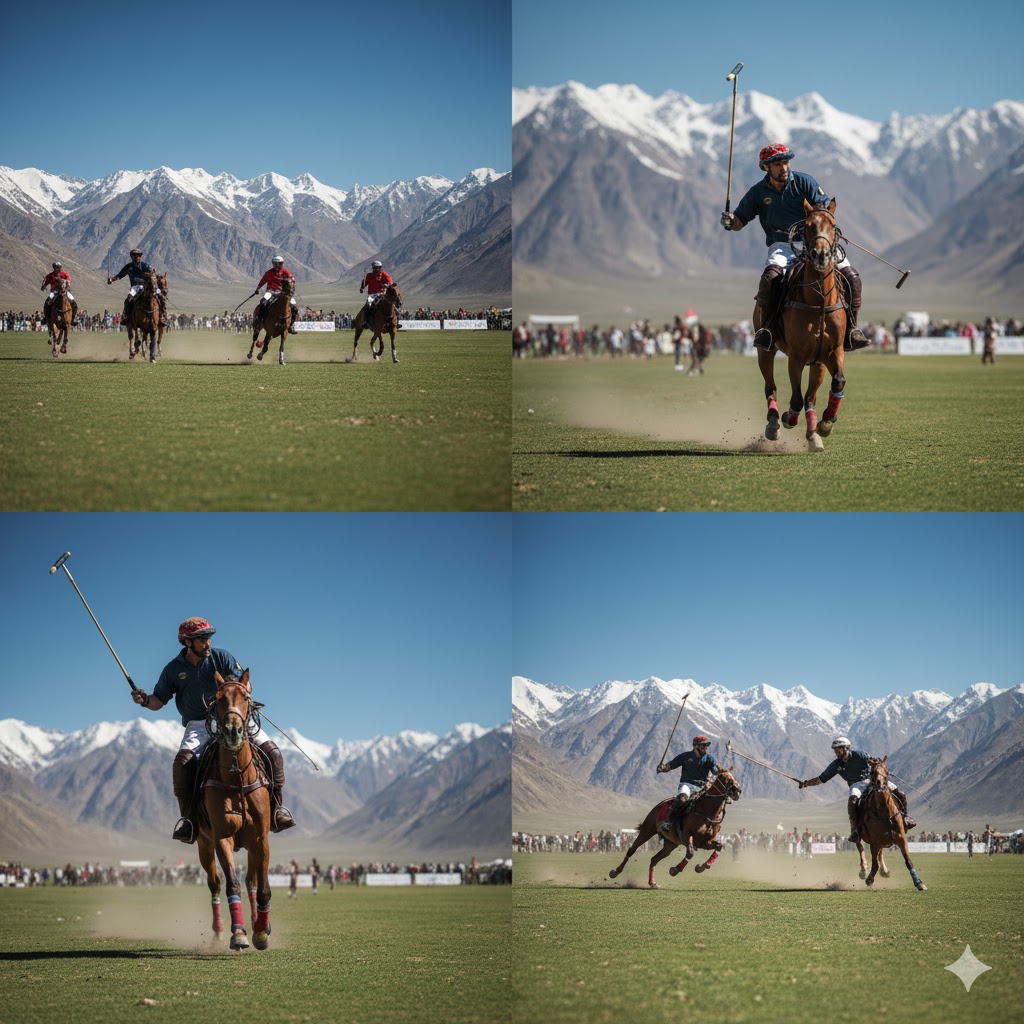
🎶 2. Balti Cultural Week
Organized in Skardu and Astore each August, this event celebrates Balti songs, dances, and cuisine. Locals wear traditional woolen robes called chugas and perform ancient drum-led dances called Surna Jang.
For travelers heading to Deosai, it’s a chance to witness the roots of Balti culture before entering the wild.
Don’t Miss: Local food stalls selling apricot dumplings and yak butter tea.
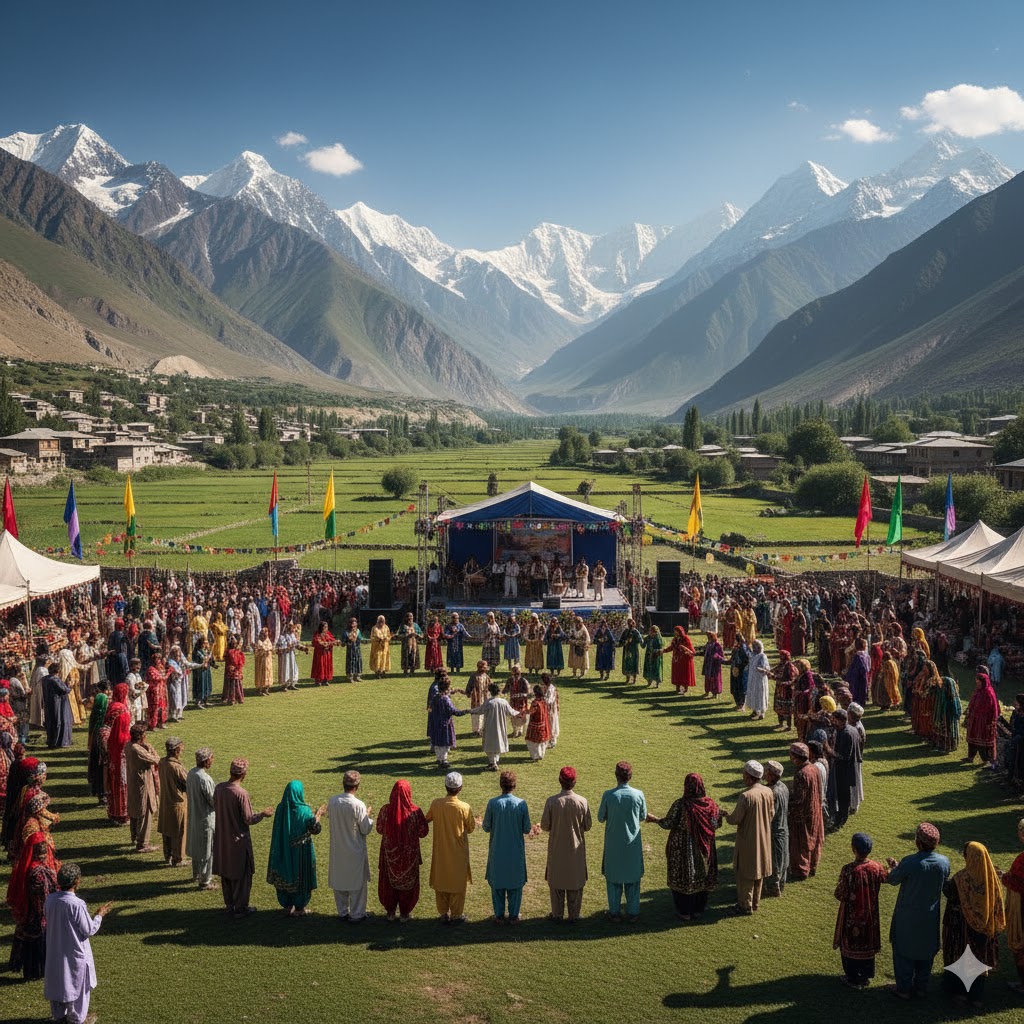
🐑 3. Nomad Migration Season
Every June, herding families begin their annual journey to Deosai’s upper meadows. This “festival of movement” isn’t official — but it’s a profound human tradition of coexisting with nature.
Travelers camping during this time can observe herders guiding yaks and sheep through misty valleys.
Ethical Travel Tip: Keep distance, avoid drones, and always ask before photographing families.
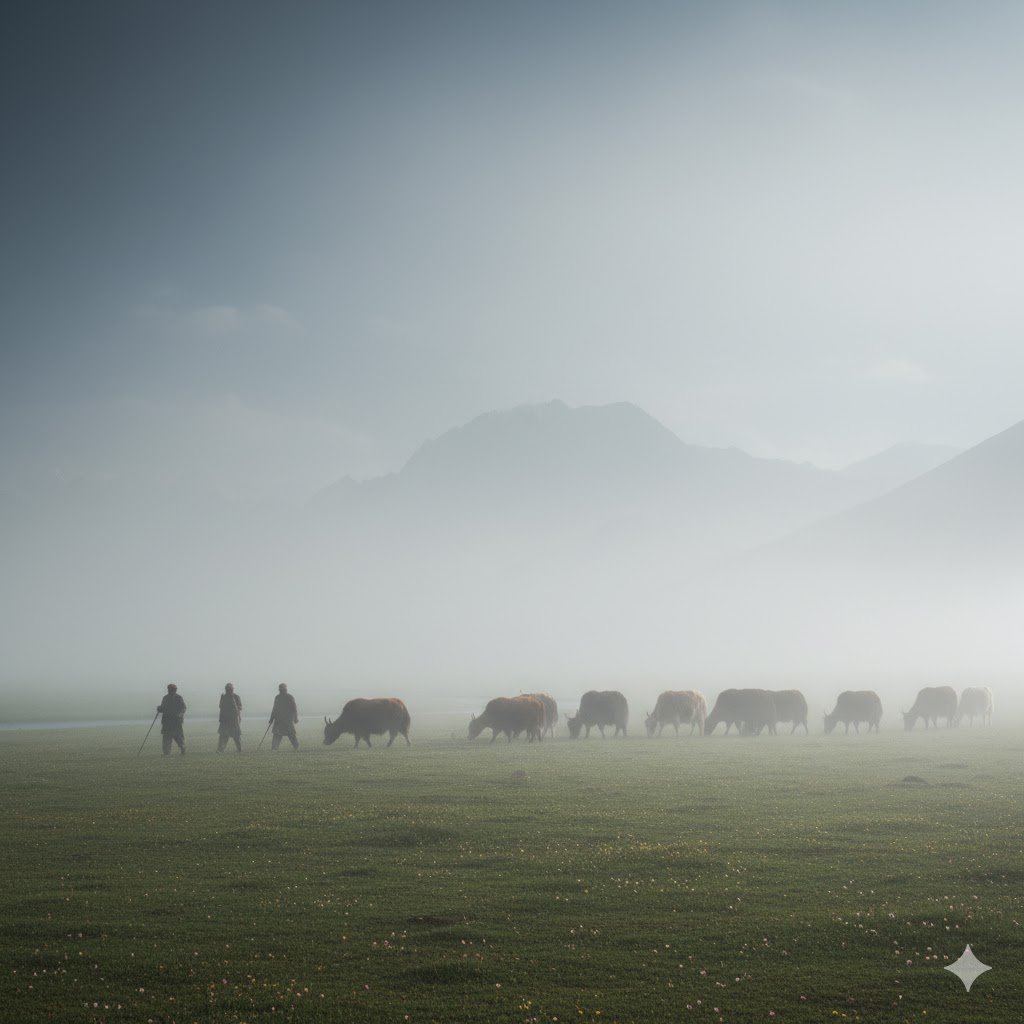
🏔️ Nearby Attractions Worth Adding to Your Deosai Trip
Deosai connects multiple scenic valleys and alpine wonders that deserve a few extra days on your itinerary.
🏞️ 1. Sadpara Lake
Only 25 km from Skardu, Sadpara Lake is the gateway to Deosai. Its turquoise waters reflect the nearby mountains, making it an excellent stop for photography.
There’s a small Sadpara village nearby where you can buy snacks and fuel before heading to the plateau.
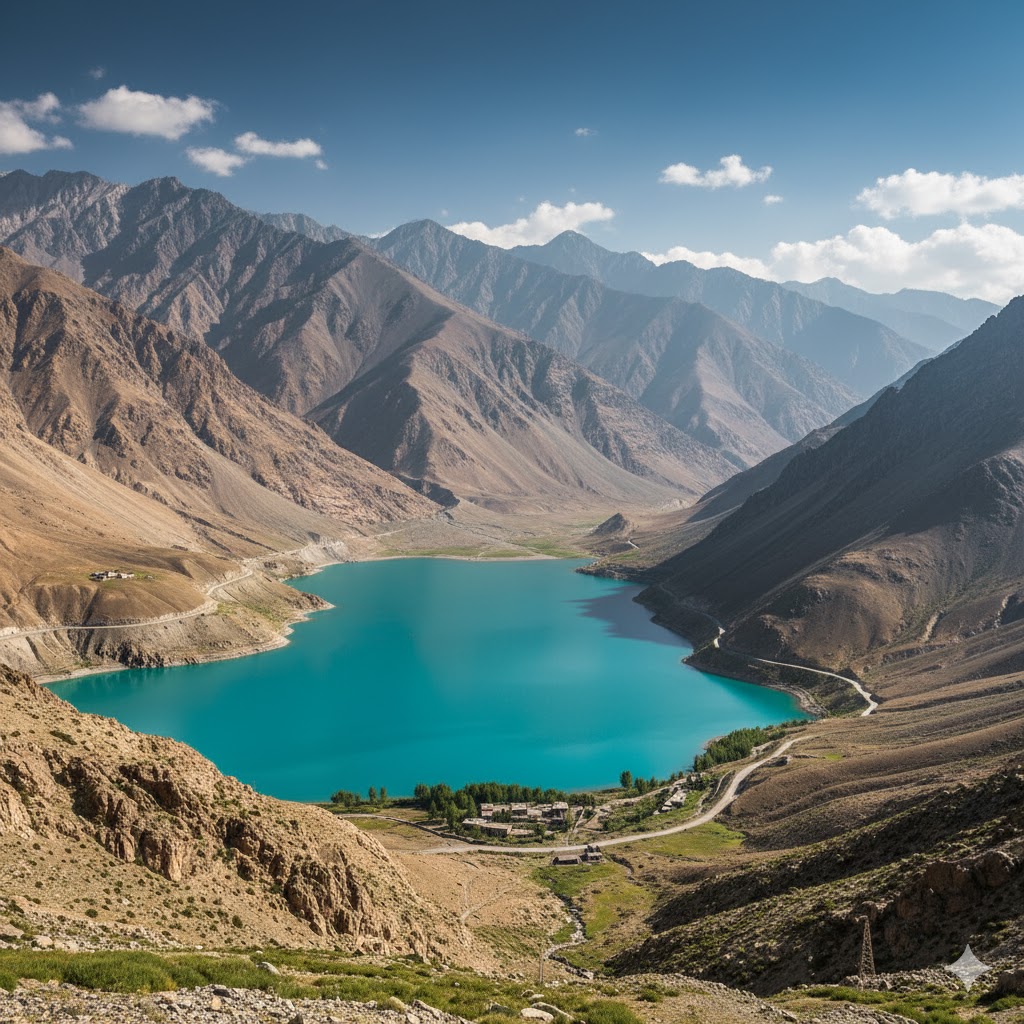
🏔️ 2. Manthal Buddha Rock
A fascinating glimpse into Baltistan’s Buddhist past, this ancient carving lies just outside Skardu. The serene figure of Buddha etched into a granite boulder tells of the region’s pre-Islamic heritage.
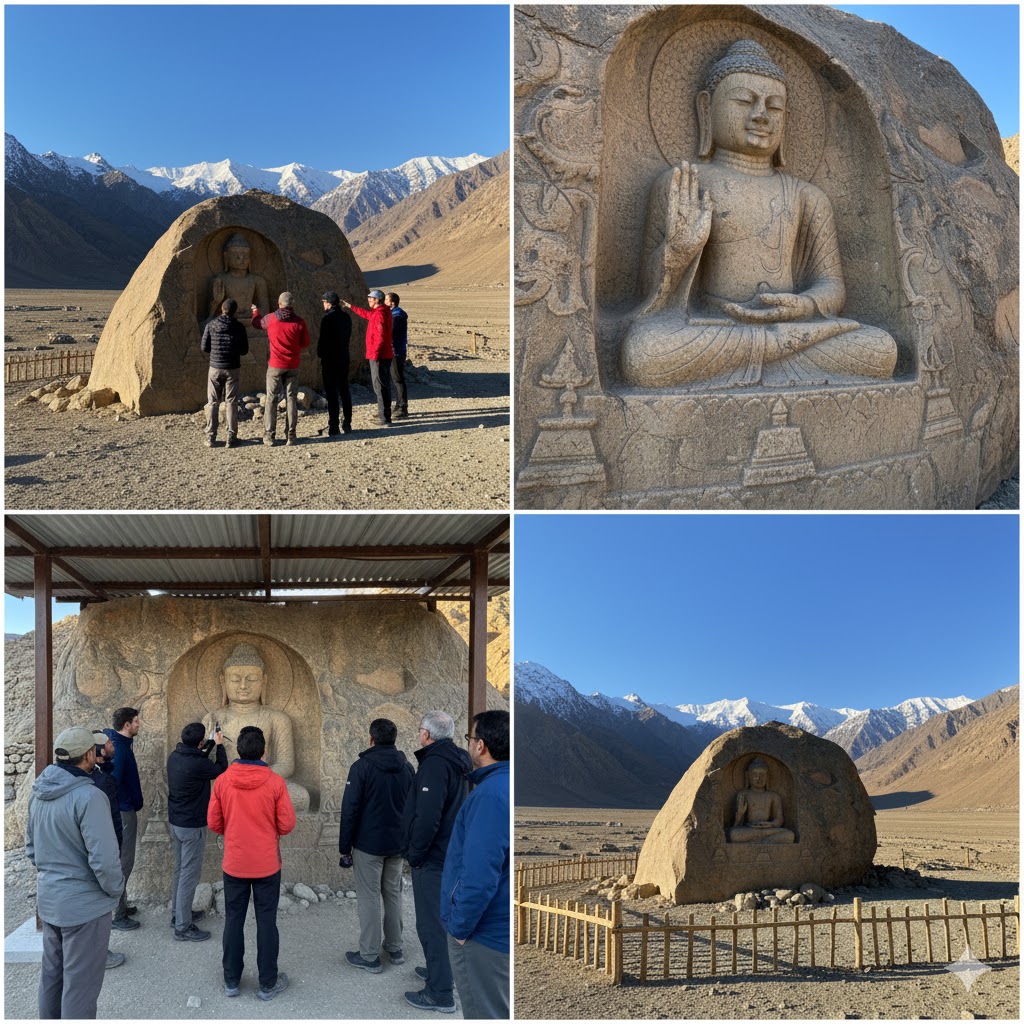
🏕️ 3. Katpana Cold Desert
Known as the “World’s Highest Cold Desert,” Katpana lies near Skardu Airport. Its rippled golden dunes are surreal under the blue sky and make a stunning contrast after Deosai’s green plains.
Perfect for drone shots or sunset photography sessions.
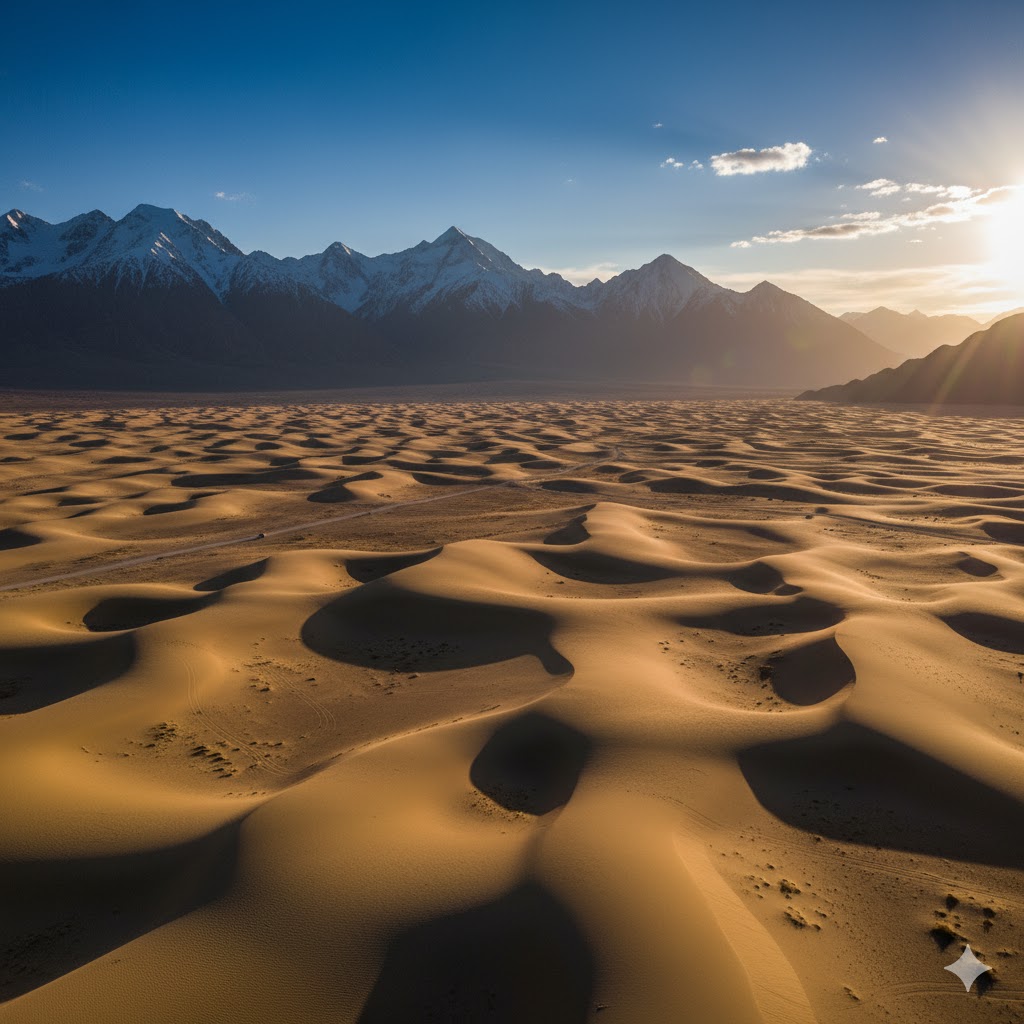
🏞️ 4. Rama Lake (via Astore Route)
If you return via Astore, take a detour to Rama Lake — a forest-lined alpine lake known for reflection photography. This route offers an entirely different perspective of Northern Pakistan.
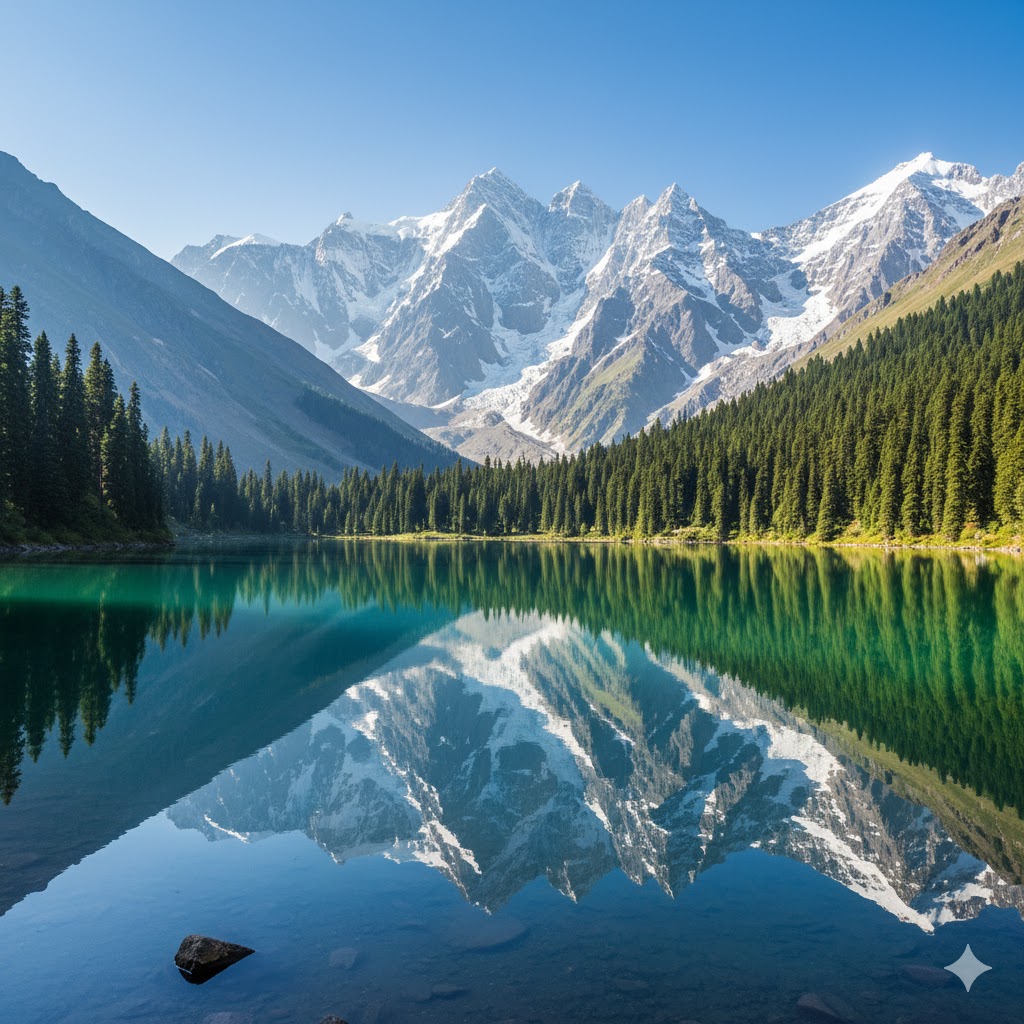
🗺️ Road Trip Itineraries: Skardu – Deosai – Astore Circle
One of Pakistan’s most breathtaking drives, this circular route offers a complete high-mountain adventure.
🚙 Option 1: The Classic Loop (4 Days)
Day 1: Skardu → Sadpara Lake → Bara Pani (camp)
Day 2: Bara Pani → Sheosar Lake → Deosai Top → Chillum (overnight lodge)
Day 3: Chillum → Rama Lake → Astore Town
Day 4: Astore → Jaglot → Skardu (return via Indus Valley highway)
🏍️ Option 2: Motorcycle Adventure (3 Days)
For bikers, Deosai is pure freedom.
- Day 1: Skardu to Bara Pani
- Day 2: Ride across Deosai plains to Sheosar Lake
- Day 3: Return via Sadpara Lake viewpoint
Safety Tip: Use knobby tires; Deosai’s gravel roads can turn muddy after rain.
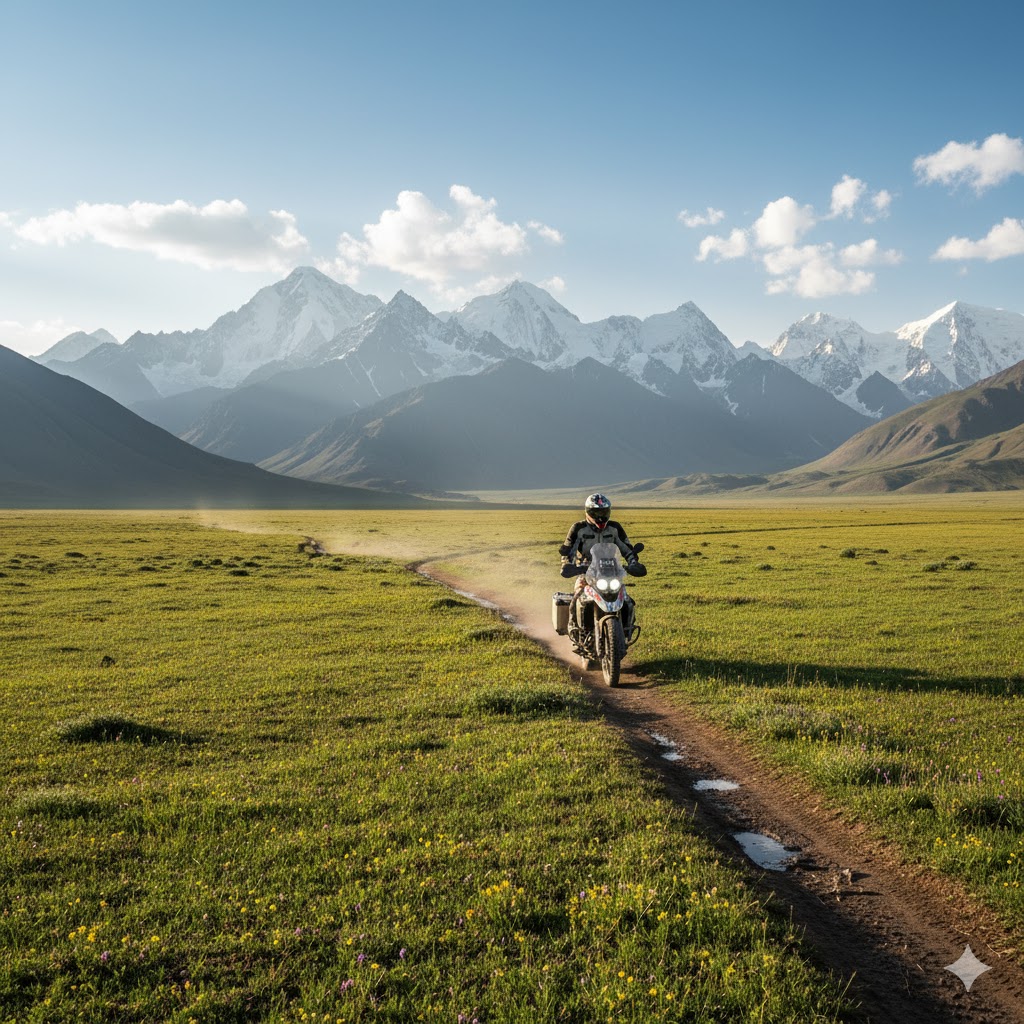
📸 Photography Workshops & Filmmaking Tours (2025 Edition)
Growing global attention has turned Deosai into a magnet for travel photographers and documentary filmmakers.
🎥 1. Milky Way & Astrophotography Workshop
Conducted every July by local guides near Bara Pani. Participants learn long-exposure techniques under Pakistan’s clearest night skies.
Bring a sturdy tripod and wide-aperture lens (f/2.8 or lower).
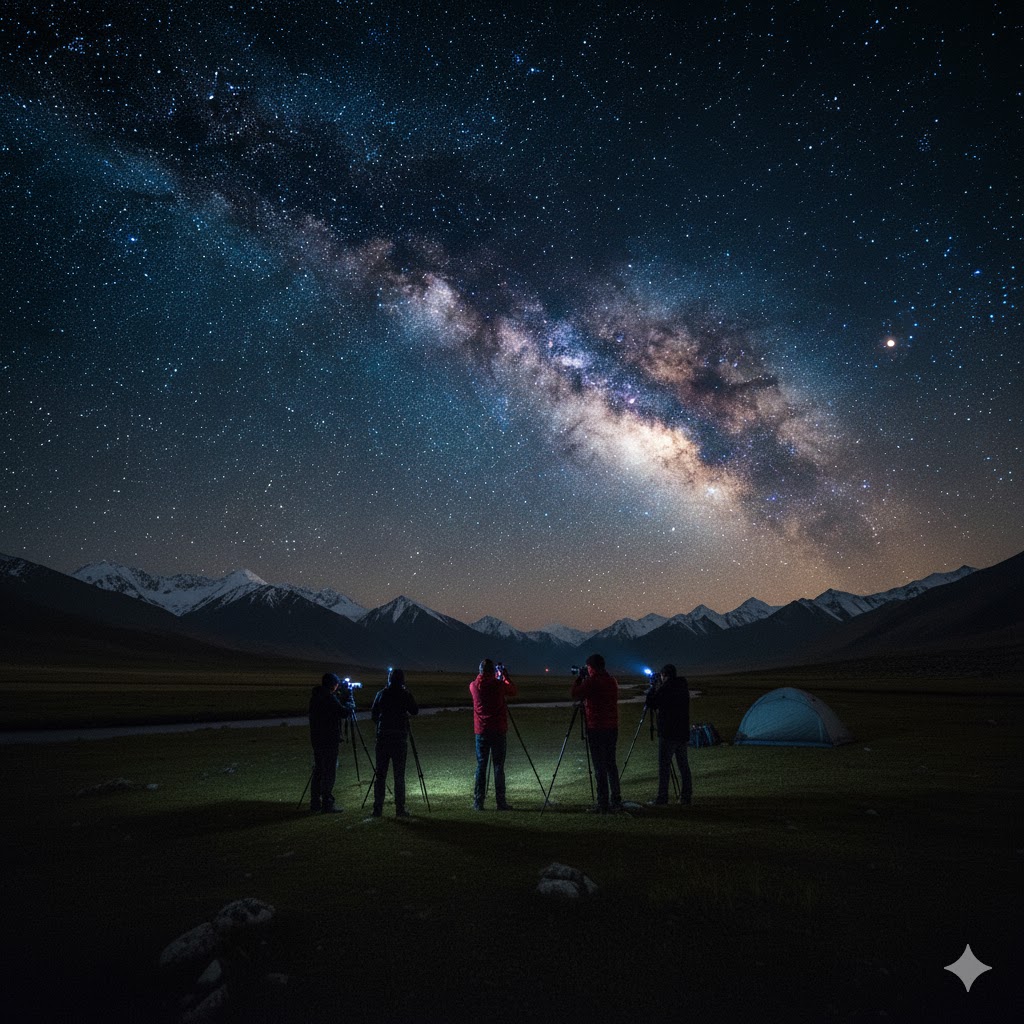
🦋 2. Wildlife & Macro Photo Tour
Organized by WWF Pakistan in collaboration with local rangers. This seasonal program allows ethical observation of Himalayan brown bears, marmots, and migratory birds.
📹 3. Travel Documentary Expedition
Several Pakistani vloggers collaborate with PTDC and Gilgit-Baltistan Tourism Department to promote responsible adventure travel. These tours include drone permits, editing support, and storytelling sessions.
🧗♂️ Adventure Add-Ons for Thrill Seekers
Deosai offers endless possibilities for adrenaline lovers who crave solitude and challenge.
🥾 1. Alpine Hiking to Kachura Extension Ridge
This off-map ridge sits beyond Bara Pani and leads to a panoramic viewpoint above Kachura Valley. The trail mixes steep ascents with flower-lined plateaus.
Duration: 6 hours round trip.
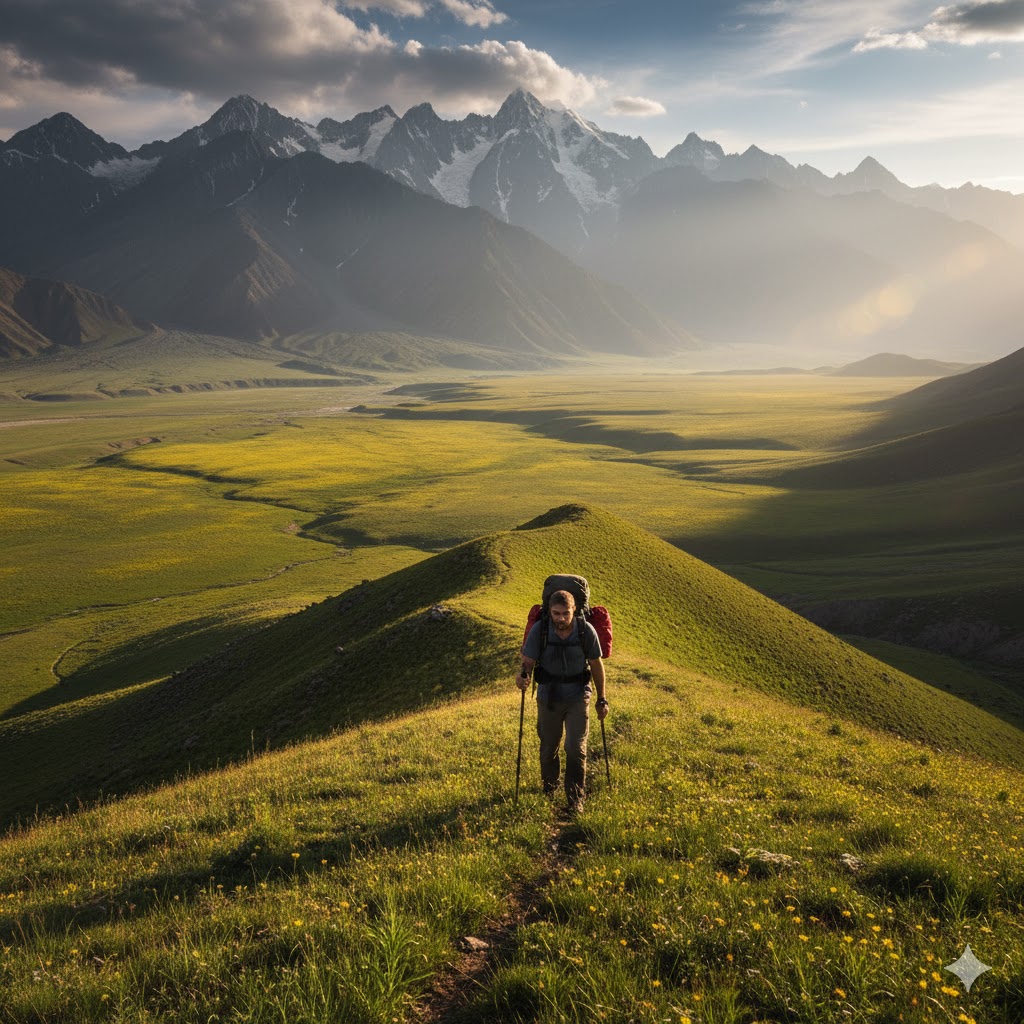
🚣 2. River-Edge Kayaking (Experimental Activity)
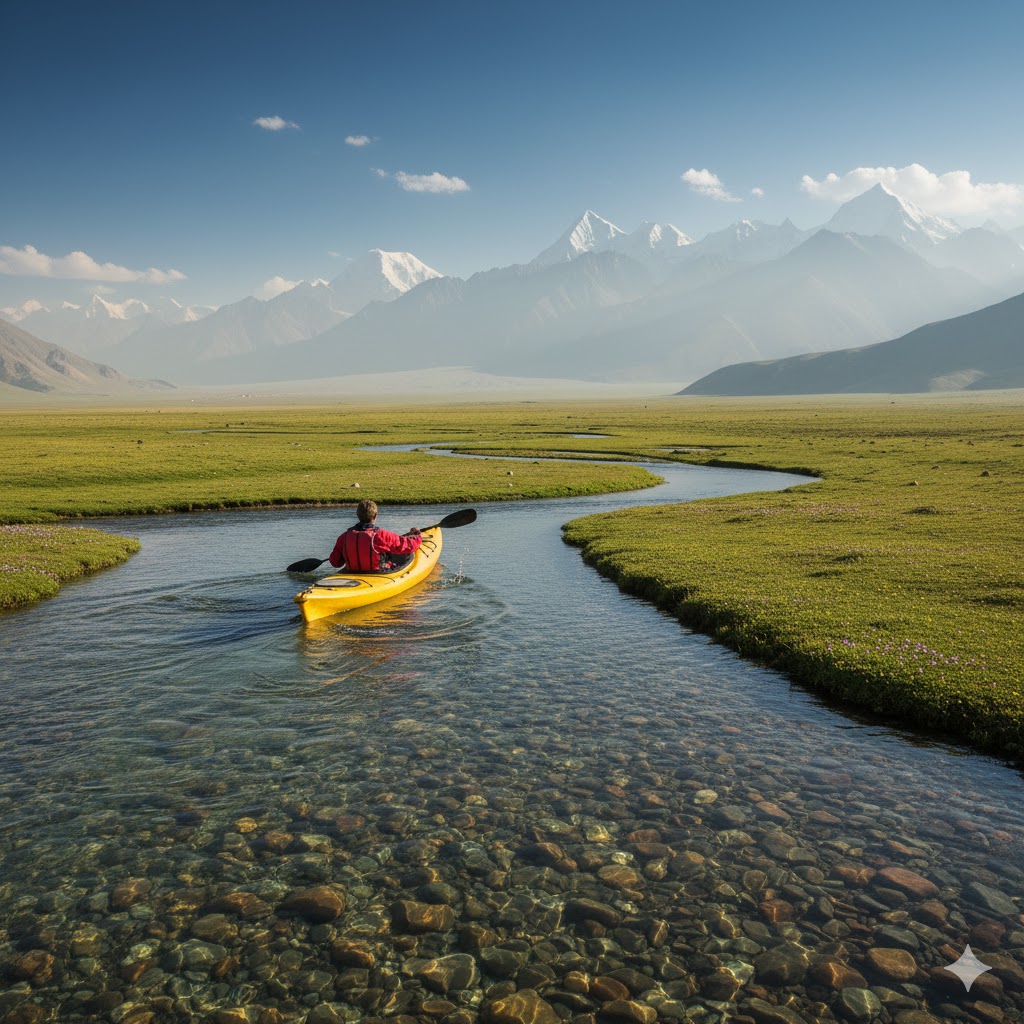
Some adventure outfitters are introducing eco-kayaking on calm sections of Bara Pani River under guided supervision. Perfect for experienced paddlers seeking a unique angle on Deosai’s reflections.
🐎 3. Horseback Trails with Local Nomads
Nomadic herders sometimes offer short horseback rides through the meadows. It’s an authentic way to explore Deosai as the locals do.
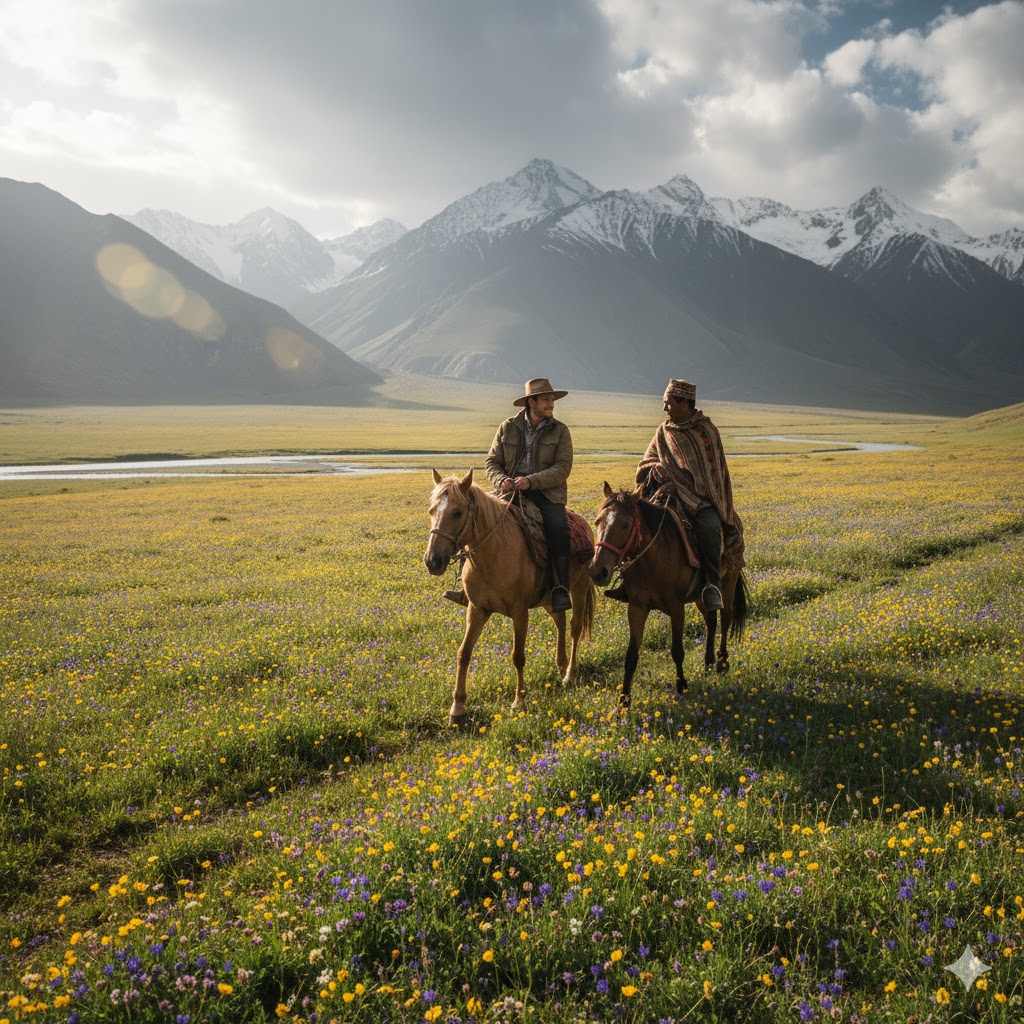
🏨 Accommodation & Glamping Options Around Deosai
Though camping remains the true Deosai experience, nearby valleys now offer eco-lodges and glamping tents for travelers who prefer comfort.
| Location | Accommodation | Facilities |
|---|---|---|
| Bara Pani Base Camp | Eco tents by local operators | Shared bathrooms, solar lights |
| Chillum Rest House | Government lodge | Basic rooms, meals available |
| Skardu Eco-Resort | Boutique glamping resort | Hot showers, dining, Wi-Fi |
| Astore Hotels | Small guesthouses | Affordable stay, jeep connections |
💬 Traveler Stories: Voices from the Wilderness
“Sleeping beside Sheosar Lake felt like being inside a dream. The Milky Way looked close enough to touch.”
— Ayesha N., Travel Blogger, Karachi
“Our jeep got stuck near Kala Pani, but a local shepherd helped us out — and served us yak milk tea! That’s the spirit of Baltistan.”
— David R., Photographer, UK
🌱 Eco-Tourism & Sustainable Practices (2025 Update)
With rising footfall, Deosai’s delicate ecosystem needs protection more than ever.
The WWF, PTDC, and local community initiatives are working toward sustainable tourism through:
- Waste-management awareness campaigns.
- Strict bans on plastic bottles.
- Solar-powered ranger stations.
- Limited jeep permits to control traffic.
Travelers can help by following “Leave No Trace” principles:
Pack it in — pack it out, minimize campfire impact, and respect wildlife habitats.
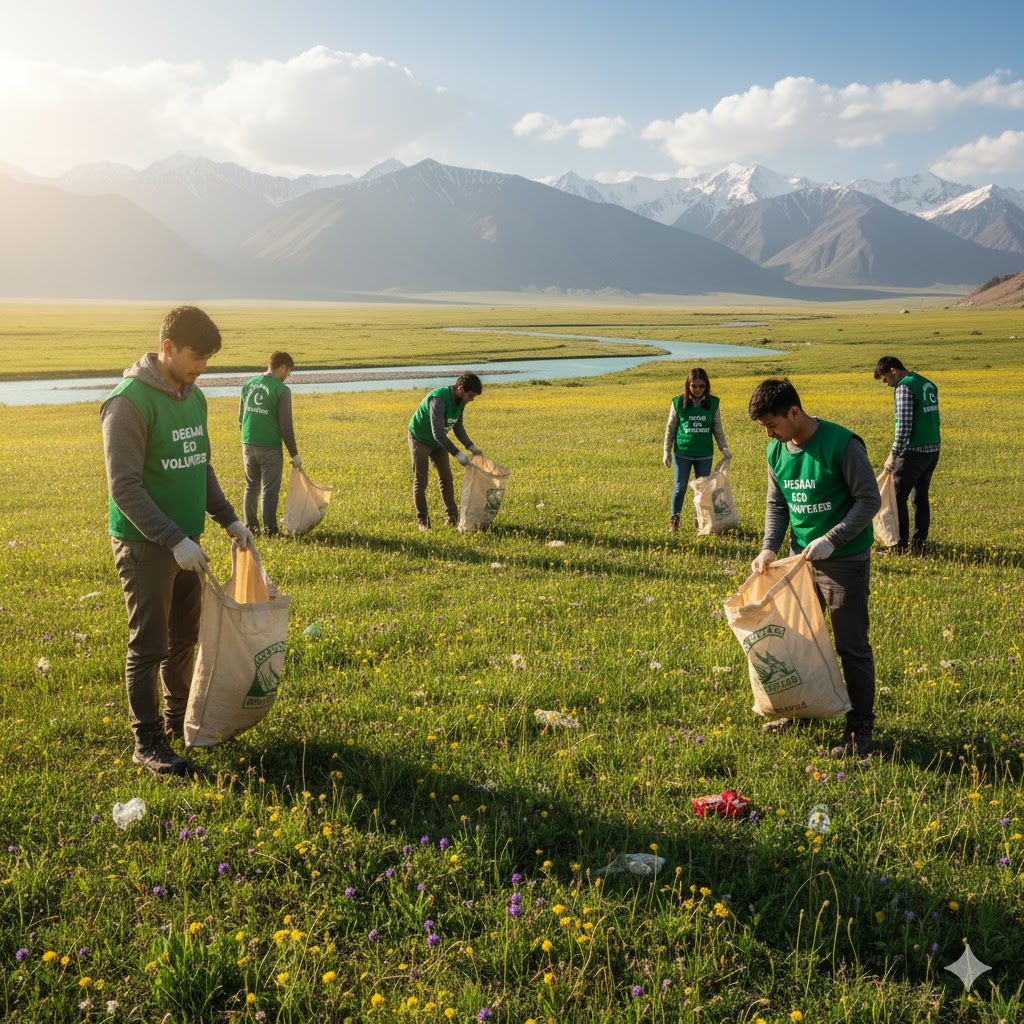
🕋 Spiritual & Mindful Travel in Deosai
Many visitors describe Deosai as a place of spiritual awakening. The sheer silence invites reflection and mindfulness.
Morning yoga by the lake, journaling beside alpine streams, or silent stargazing can all become forms of meditation.
Mindful Practice Idea: Sit near the riverbank at dawn, close your eyes, and listen — the sound of flowing water and wind becomes pure therapy.
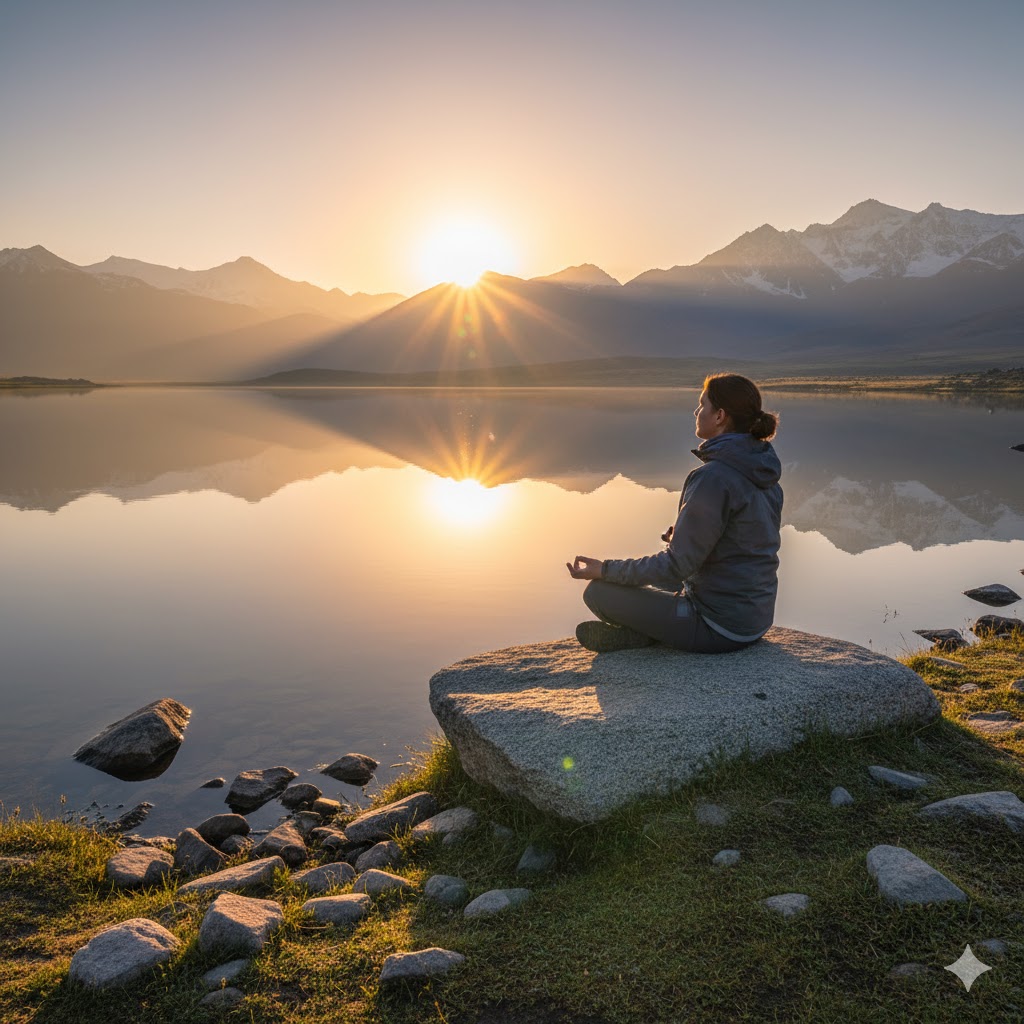
🧭 Extended Gilgit-Baltistan Road Network: Where to Go Next
After exploring Deosai, extend your journey into neighboring wonders:
- Khaplu Valley – Famous for orchards and centuries-old Khaplu Fort.
- Shigar Valley – Gateway to K2; includes the Shigar Fort Residence.
- Satpara Lake Village – Offers yak rides and boating for families.
- Upper Kachura Lake – Crystal-clear waters ideal for short hikes.
Internal link: Top Scenic Routes in Gilgit-Baltistan (2025)
💡 Practical Tips for a Perfect Deosai Journey
- Permits: Always carry national ID or passport copies for checkpoints.
- Fuel: Top up at Skardu — no stations inside Deosai.
- Weather: Afternoon rains arrive suddenly; set tents early.
- Wildlife: Store food inside sealed containers.
- Photography: Keep spare batteries; cold drains power quickly.
- Local Support: Hire Balti drivers — their knowledge ensures safer navigation.
🧩 Safety & Rescue Information (Updated 2025)
- Emergency Contact: Gilgit-Baltistan Rescue 1122 operates limited patrols near Sadpara Gate.
- Ranger Posts: Located at Bara Pani, Kala Pani, and Sheosar Lake.
- Medical Support: CMH Skardu (Army Hospital) and Astore RHC are nearest facilities.
- Wildlife Encounters: Stay calm, back away slowly, never run.
Wildlife Encounters: The Untamed Spirit of Deosai
Deosai National Park is often called the “Land of Giants”, not just for its grand landscapes but also for its majestic inhabitants. The most iconic resident here is the Himalayan Brown Bear, one of the rarest bear species on Earth. Once on the brink of extinction, their population has rebounded thanks to conservation efforts. Early morning or dusk around Bara Pani and Kala Pani are the best times for spotting them from a safe distance — always use binoculars and avoid disturbing their natural behavior.
Besides the bears, Deosai’s wilderness shelters golden marmots, snow leopards, Himalayan ibex, foxes, and over 200 species of migratory birds including the Lammergeier vulture and golden eagle. During summer, wildflowers carpet the plains, creating a paradise for butterflies and pollinators — a photographer’s dream.
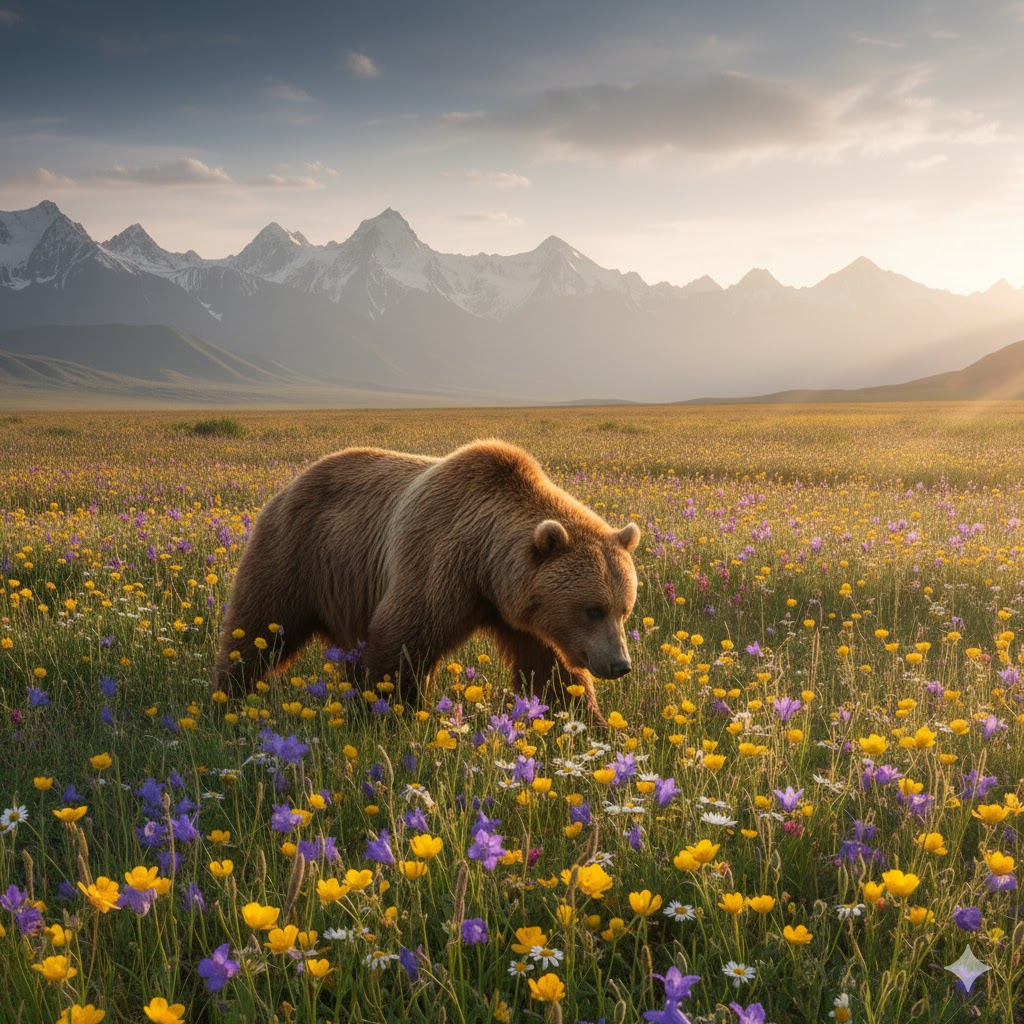
🏕️ Best Camping Spots in Deosai
When it comes to camping, not every corner of Deosai is ideal — the park’s high altitude (4,100 meters) means unpredictable weather, strong winds, and cold nights. However, a few prime locations provide safe, scenic, and accessible camping experiences:
- Bara Pani – Central Deosai’s most popular camping area with river access and jeep parking. You’ll find designated camp zones near the bridge.
- Sheosar Lake – For a surreal sunrise view reflecting the Nanga Parbat peak, this spot is unbeatable. Be mindful of the altitude and chill winds.
- Kala Pani – Quieter and great for solitude seekers. The valley’s curves block strong winds, making it excellent for overnight stays.
- Deosai Top (Ali Malik Pass) – Ideal for seasoned trekkers who want to wake up to endless views of the plains.
Each campsite offers unique scenery — from mirror-like lakes to sweeping flower valleys. Local guides can help with firewood, tents, and safety gear.
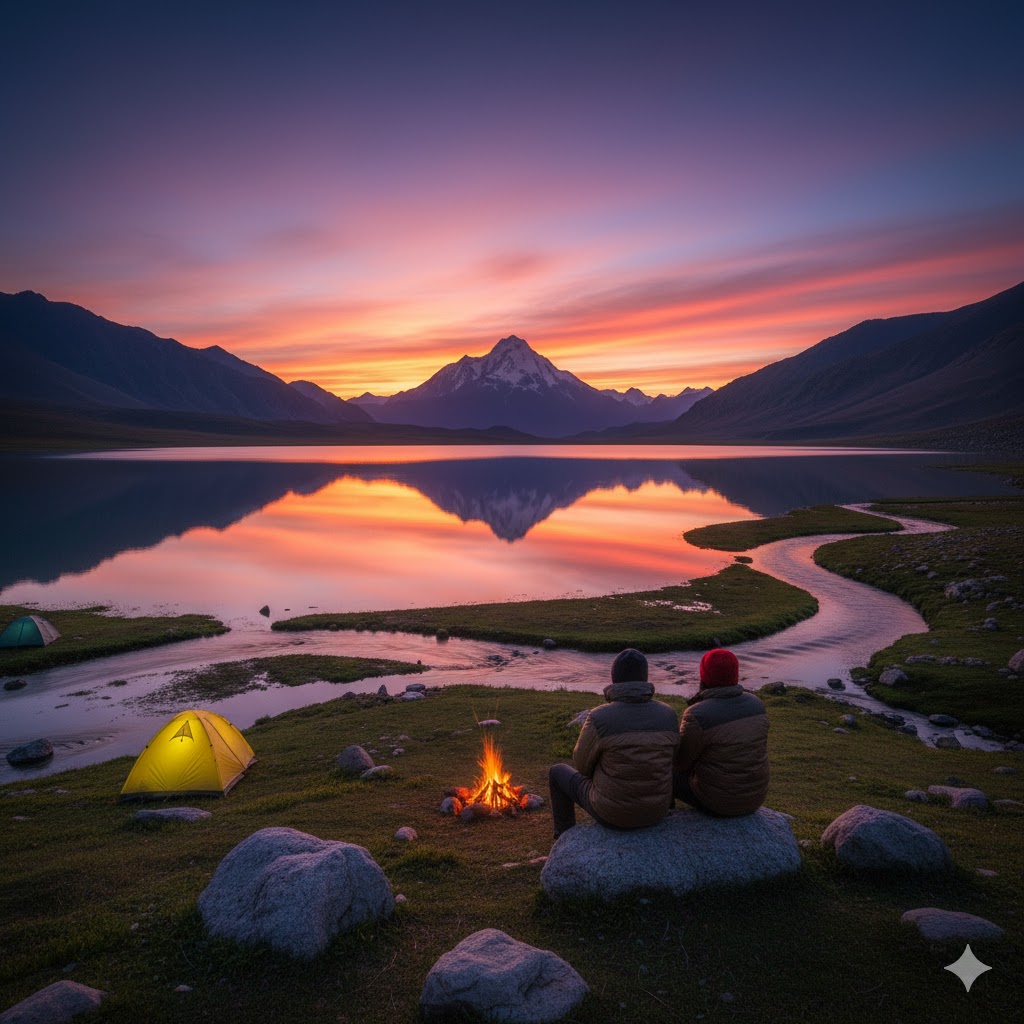
🌌 Star Gazing: A Cosmic Experience
Deosai’s isolation makes it one of Pakistan’s best stargazing destinations. With zero light pollution, the night sky transforms into a cosmic spectacle of the Milky Way, especially between June and September. Campers often describe the experience as spiritual — sitting by a bonfire while the galaxy shines above the meadows.
Bring a tripod for astrophotography; set your ISO between 1600–3200 and capture long exposures for brilliant star trails. Those interested in astronomy can join guided night sessions arranged by Astro-tourism groups from Skardu or Islamabad.
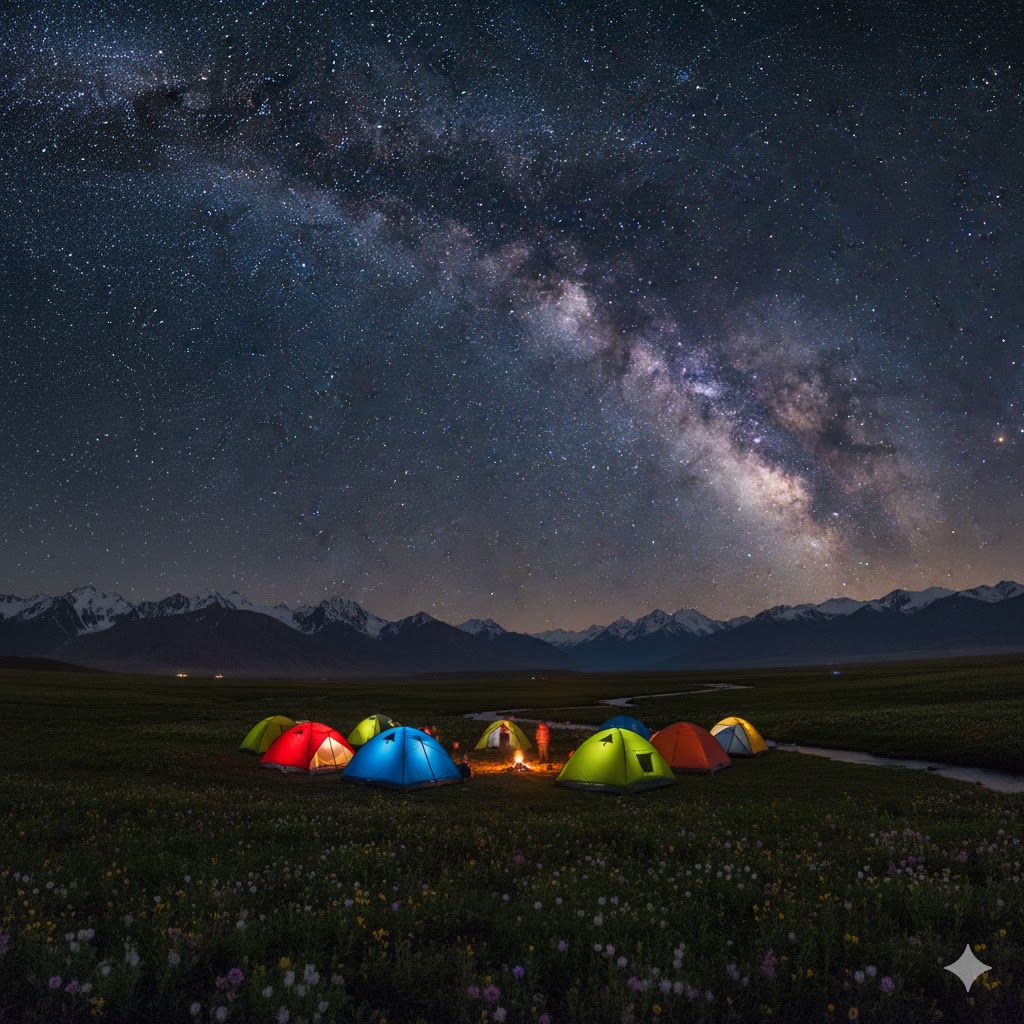
🧭 How to Reach Deosai
There are two main routes to reach Deosai:
- Skardu Route: The most common access point. From Skardu city, a Jeep safari (2–3 hours) takes you through Satpara Lake, leading to Deosai Plains via Ali Malik Pass.
- Astore Route: More adventurous and rugged, this route enters from Chilum Chowki, offering breathtaking mountain views and fewer crowds.
Public transport options are limited; hiring a 4×4 vehicle with a local driver is recommended. Visitors should carry fuel, food, and extra warm layers since there are no permanent facilities or shops inside the park.
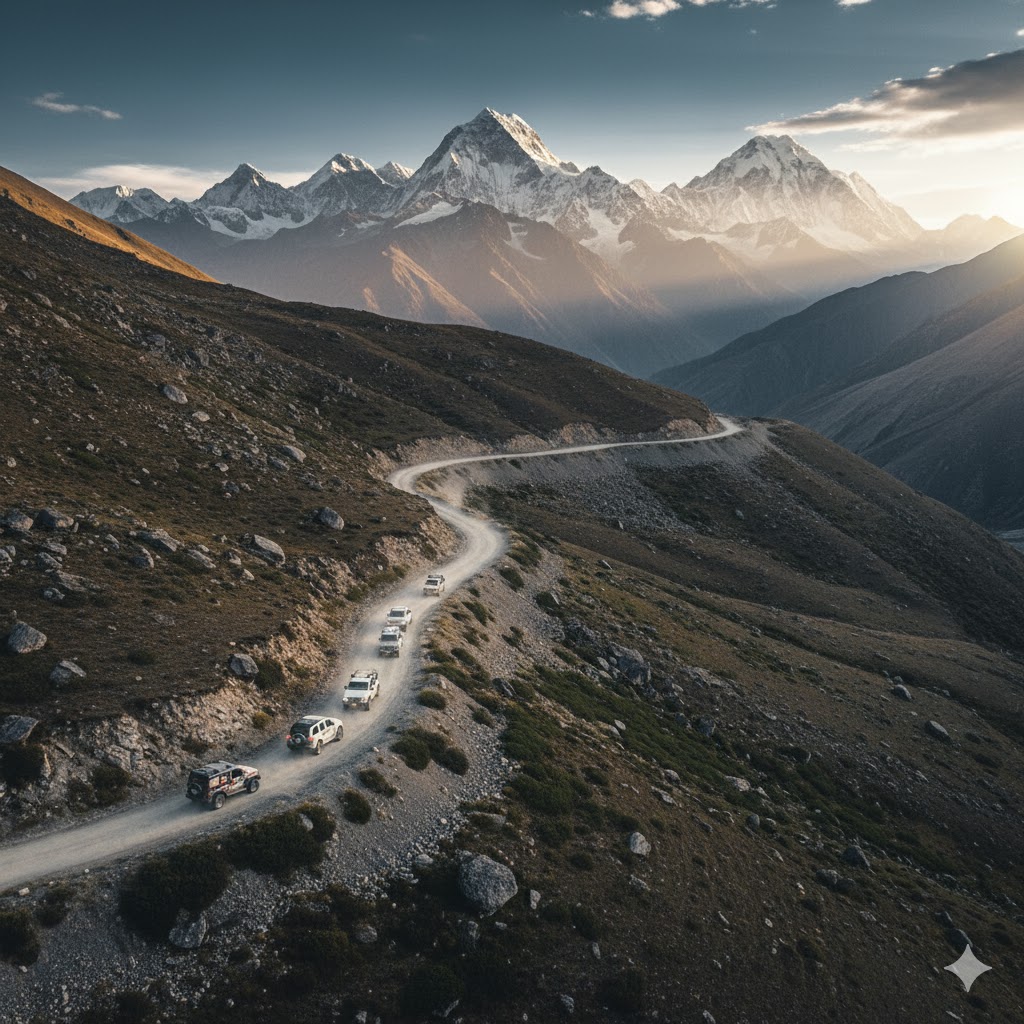
💡 Local Experiences & Hospitality
One of the best parts of camping in Deosai is meeting Balti locals from Skardu and nearby valleys. These mountain people are incredibly welcoming — offering chai (tea), sharing stories about snowstorms, and guiding visitors to hidden meadows or secret fishing spots. You can even buy handcrafted Balti wool shawls and yak milk cheese from roadside stalls during your journey.
Some tour operators also collaborate with local guides to provide eco-camping setups that focus on sustainability — using biodegradable materials and solar-powered lighting. Supporting these initiatives ensures your visit contributes positively to the local community and environment.
⚠️ Safety & Camping Regulations
Since Deosai is a protected national park, there are several rules you must follow:
- Open fires are restricted — always use a portable camping stove.
- Dispose of all waste properly; do not leave any plastic behind.
- Avoid loud music; wildlife is sensitive to noise.
- Maintain a minimum 200-meter distance from wild animals.
- Camping permits are required; obtain them from the Wildlife Department Office in Skardu before your trip.
The weather can shift rapidly — sunshine can turn into hail within minutes. Always carry extra insulation layers, water filters, and emergency gear.
🏞️ Photography & Drone Guidelines
Photography enthusiasts will find endless frames in Deosai — from blooming purple flowers to glacial streams. However, drone use is restricted without prior permission from the park authorities due to wildlife protection regulations. If you do use drones, fly above 100 meters and avoid disturbing nesting birds or bears.
Pro Tip: Early morning light around 6–8 AM creates golden tones over the plains — ideal for landscape shots.
Best Camping Spots in Deosai (Updated with Glamp Pakistan)
When it comes to camping, not every corner of Deosai is ideal — the park’s high altitude (4,100 meters) means unpredictable weather, strong winds, and cold nights. However, a few prime locations provide safe, scenic, and accessible camping experiences:
- Bara Pani – Central Deosai’s most popular camping area with river access and jeep parking. You’ll find designated camp zones near the bridge.
- Sheosar Lake – For a surreal sunrise view reflecting Nanga Parbat, this spot is unbeatable. Be mindful of the altitude and chill winds.
- Kala Pani – Quieter and great for solitude seekers. The valley’s curves block strong winds, making it excellent for overnight stays.
- Glamp Pakistan Camps – Located near Bara Pani and Sheosar Lake, Glamp Pakistan provides luxurious tents with proper insulation, camping beds, and eco-friendly amenities. It’s ideal for travelers who want comfort without missing the wild Deosai experience.
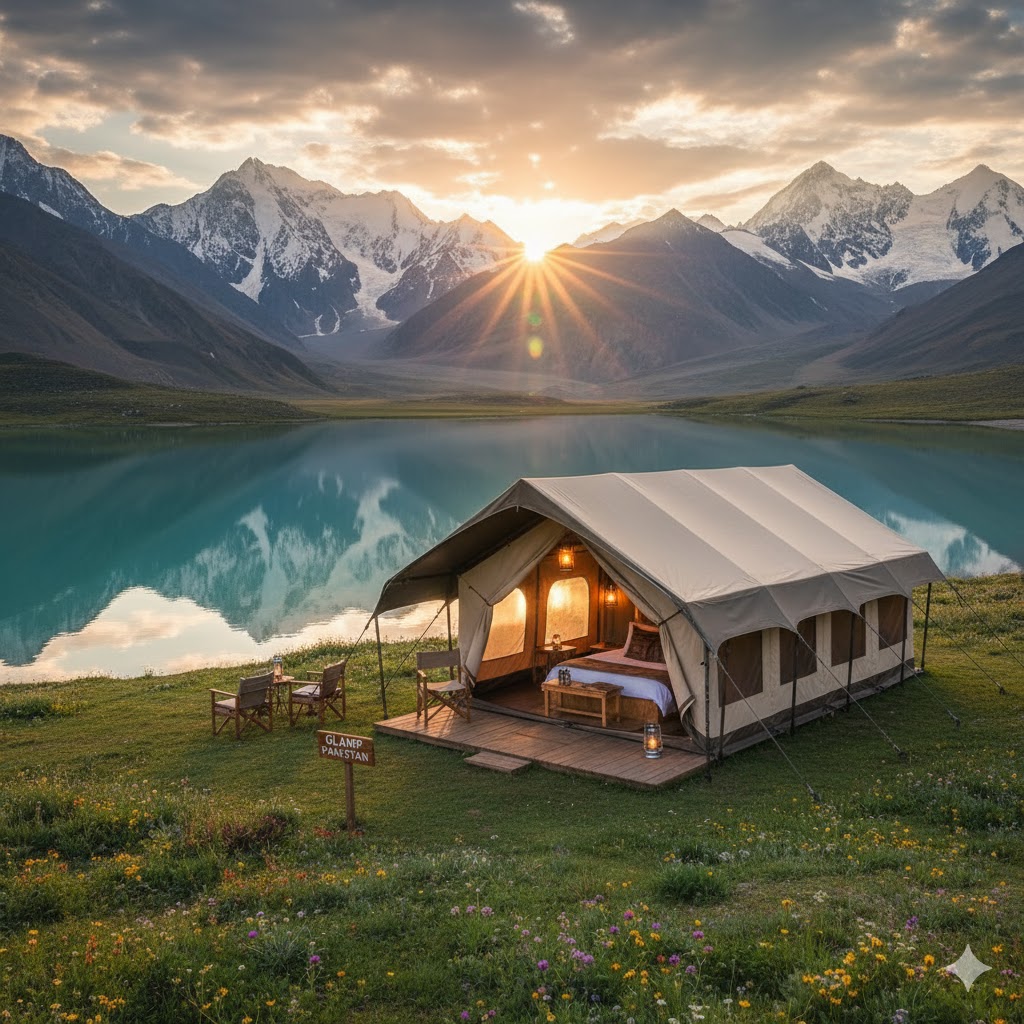
💡 Local Experiences & Hospitality (Updated)
Glamp Pakistan also collaborates with local Balti guides to provide curated camping and adventure experiences. Guests can enjoy:
- Traditional yak butter tea and Balti meals.
- Guided treks to hidden meadows and vantage points.
- Wildlife observation sessions led by trained rangers.
Supporting Glamp Pakistan ensures your visit is eco-friendly, culturally respectful, and safe, while contributing to local communities.
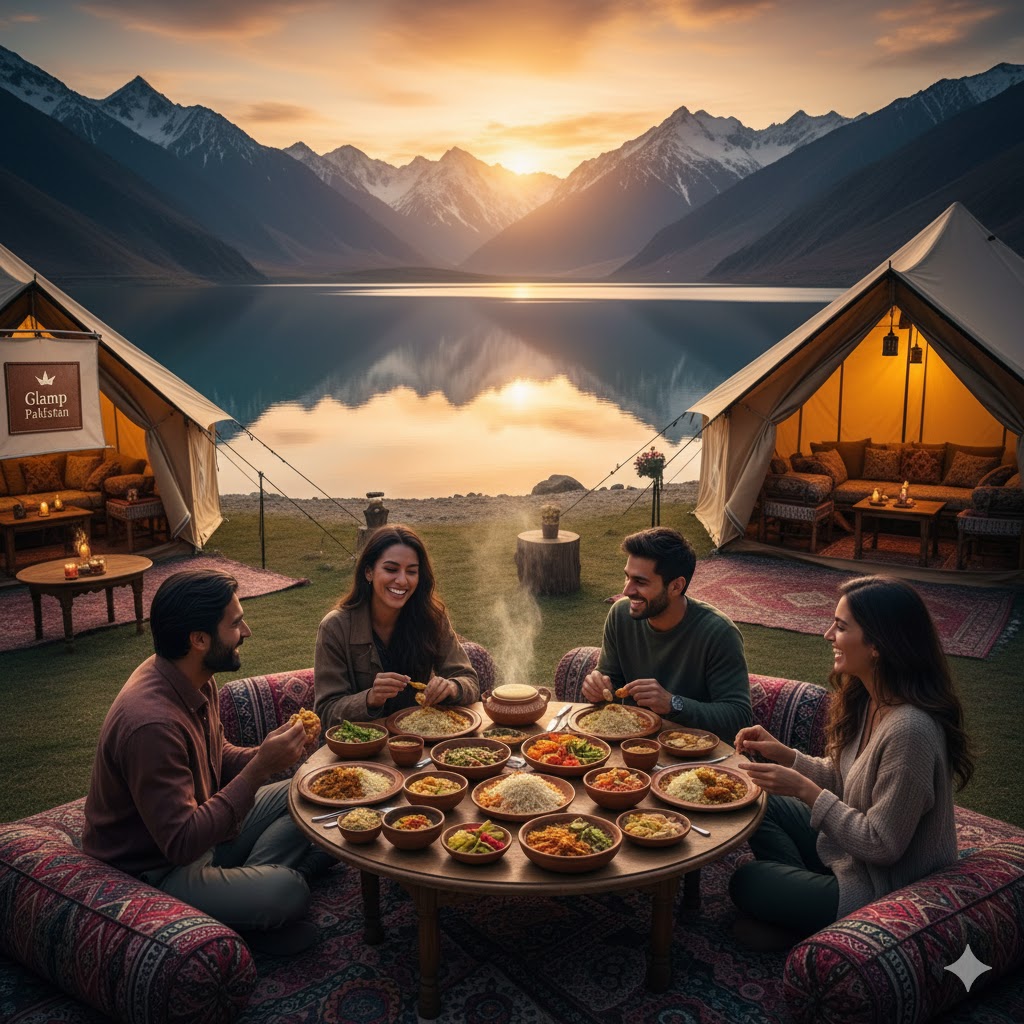
Traditional Camping in Deosai
Budget-Friendly Options:
- Basic Camps with Sleeping Bags:
- Cost: PKR 5,000 per night (for 6 people)
- Facilities: Includes sleeping bags; shared facilities
- Camps with Mattresses:
- Cost: PKR 7,000 per night (for 6 people)
- Facilities: Includes mattresses; shared facilities
These options are ideal for groups seeking an authentic, budget-friendly camping experience in Deosai North On Wheels.
🌟 Glamping with Glamp Pakistan
Luxury Camping Options:
- Adventurers’ Lair:
- Cost: PKR 15,000 per night (for 2 persons)
- Includes: Breakfast
- Extra Bed: PKR 1,500
- Viewers Den:
- Cost: PKR 20,000 per night (for 2 persons)
- Includes: Breakfast
- Arch of View:
- Cost: PKR 26,000 per night (for 2 persons)
- Includes: Breakfast
- Extra Bed: PKR 2,500
- Discovery Domes:
- Cost: PKR 42,000 per night (for 2 persons)
- Includes: Breakfast
- Extra Bed: PKR 2,500
These glamping options offer a blend of comfort and nature, providing amenities like solar-powered lighting, heating, and shared bathrooms Deosai Glamp.
🚗 Additional Costs
- Deosai Entry Fee:
- Pakistani Nationals: PKR 500
- Foreigners: USD 30
- Jeep Safari (Optional):
- Cost: Approximately PKR 8,000 per person for a full-day tour
These fees are essential for park entry and optional guided tours
✅ Summary Comparison
| Option | Cost (per night) | Includes Breakfast | Extra Bed Charges | Ideal For |
|---|---|---|---|---|
| Basic Camp (6 people) | PKR 5,000 | No | N/A | Budget travelers, groups |
| Mattress Camp (6 people) | PKR 7,000 | No | N/A | Budget travelers, groups |
| Adventurers’ Lair | PKR 15,000 | Yes | PKR 1,500 | Couples, small groups |
| Viewers Den | PKR 20,000 | Yes | N/A | Couples, small groups |
| Arch of View | PKR 26,000 | Yes | PKR 2,500 | Couples, small groups |
| Discovery Domes | PKR 42,000 | Yes | PKR 2,500 | Luxury seekers, couples |

